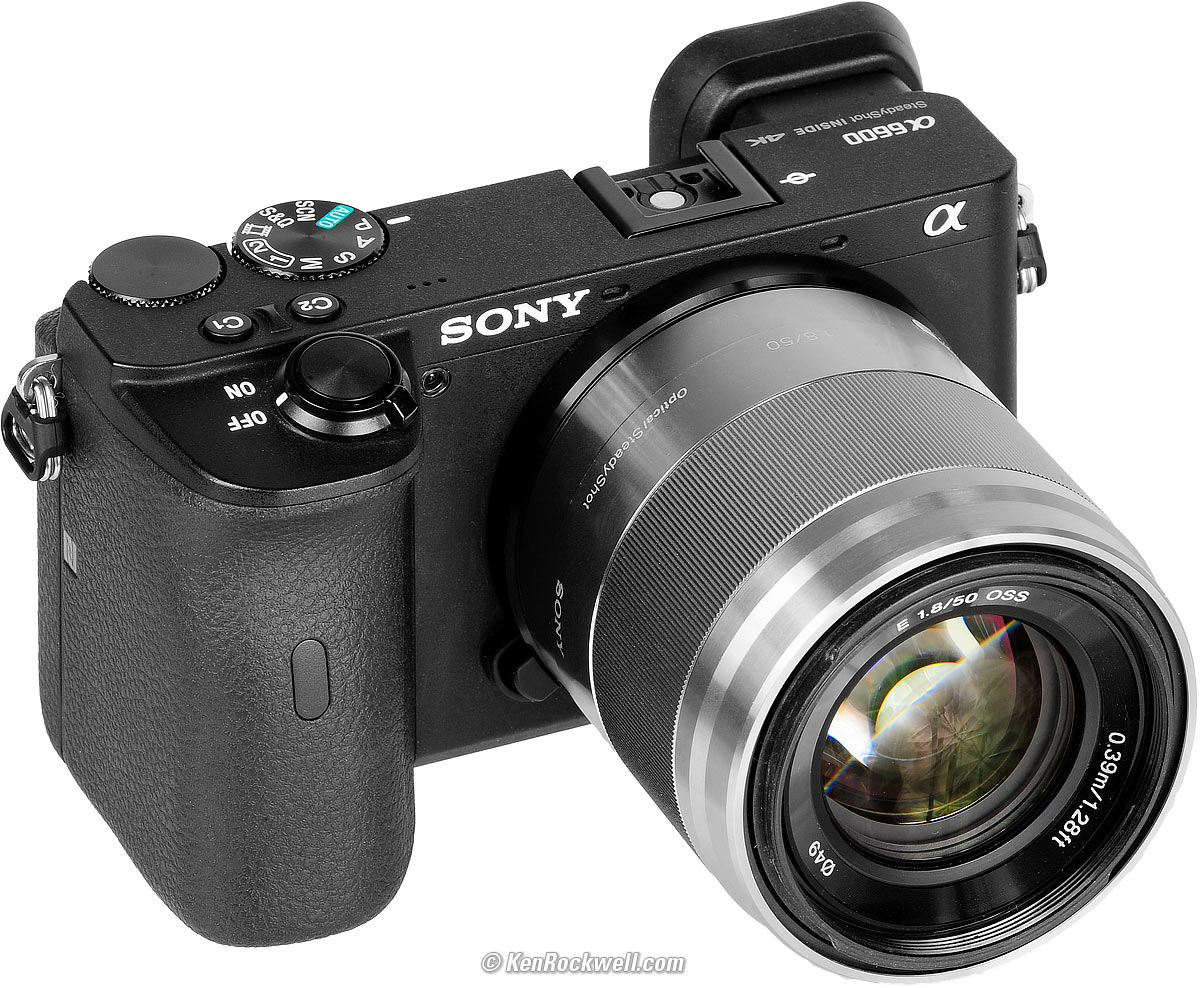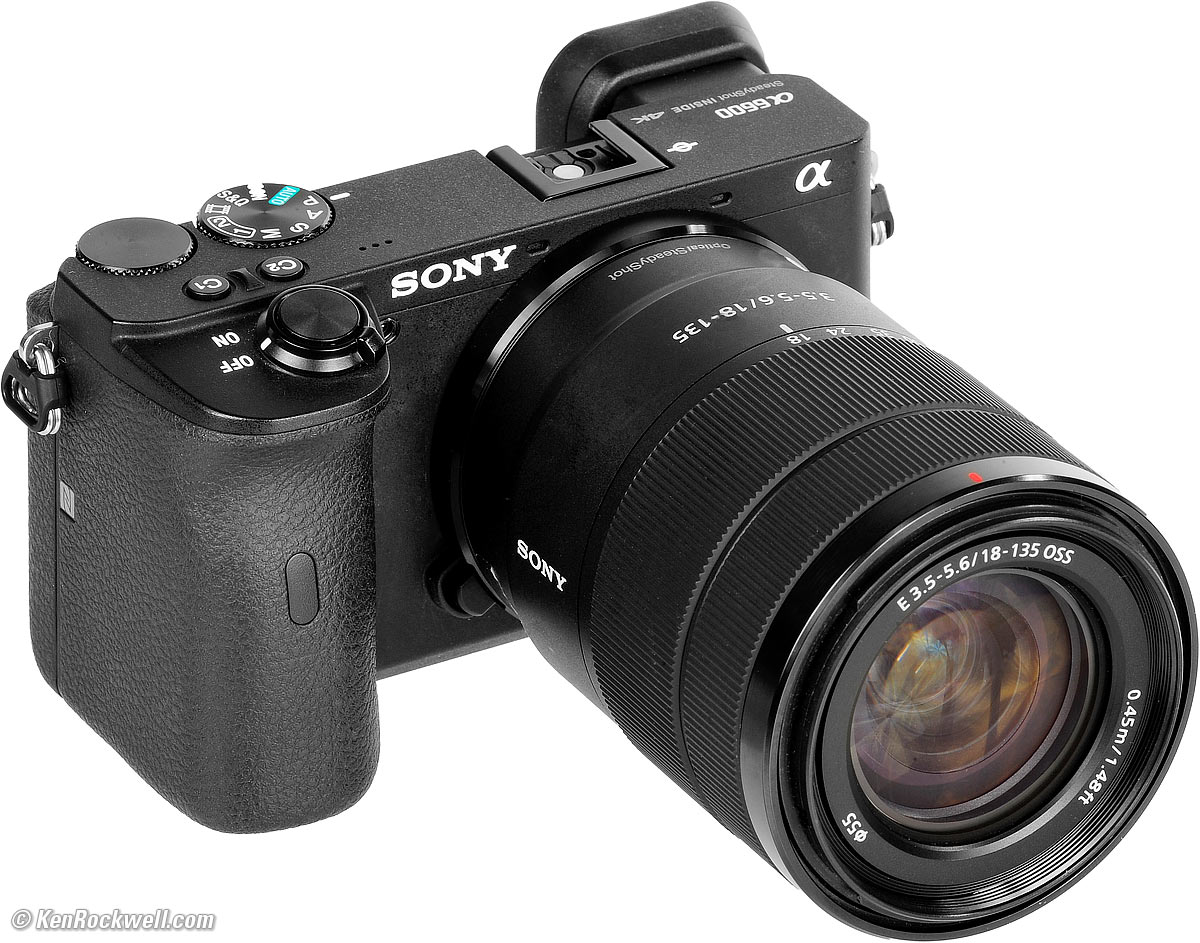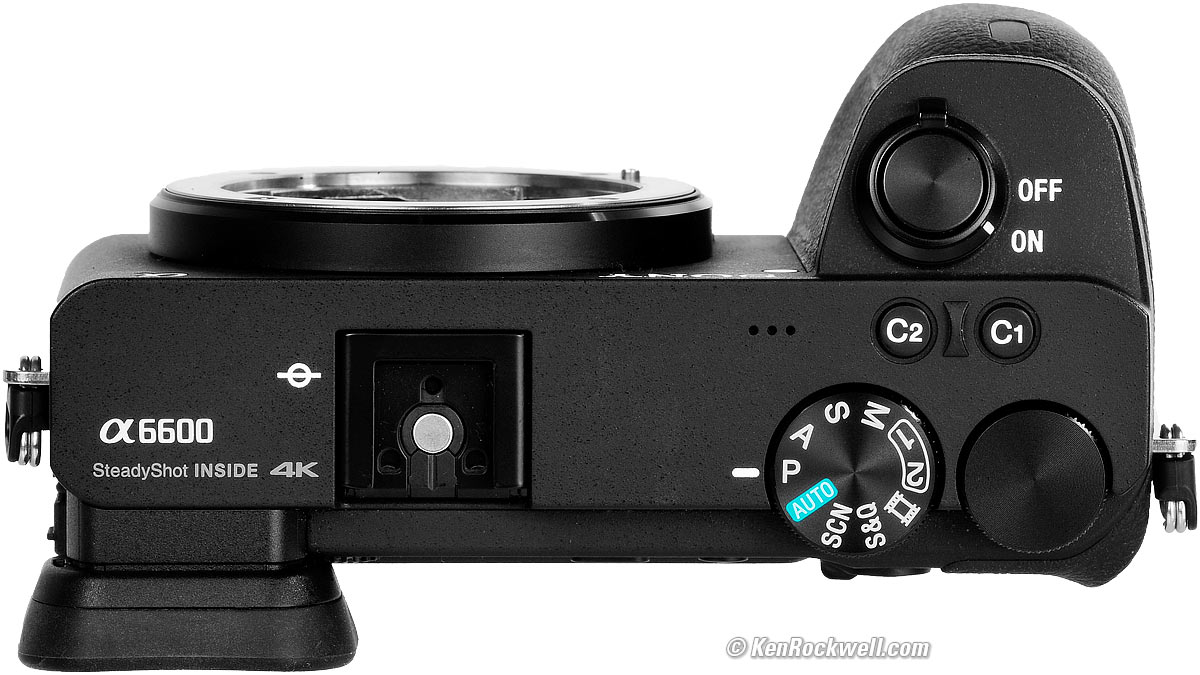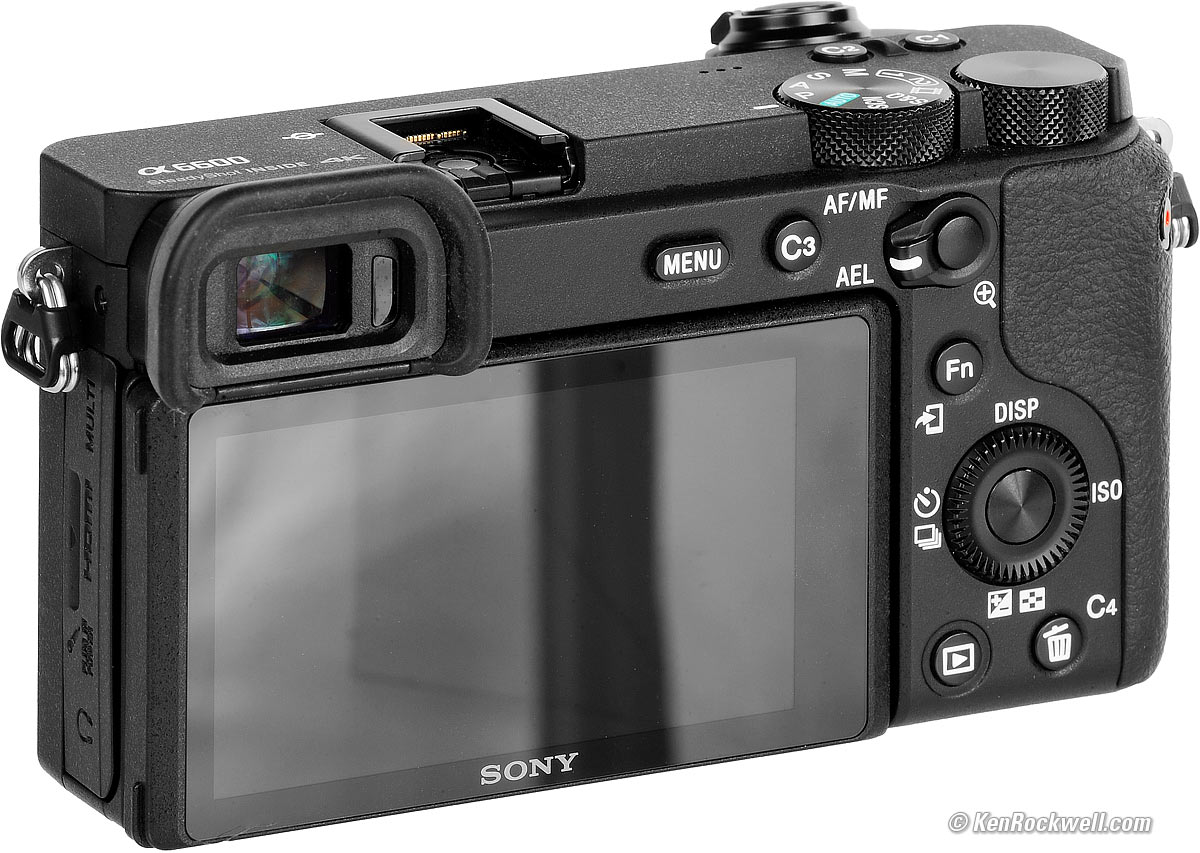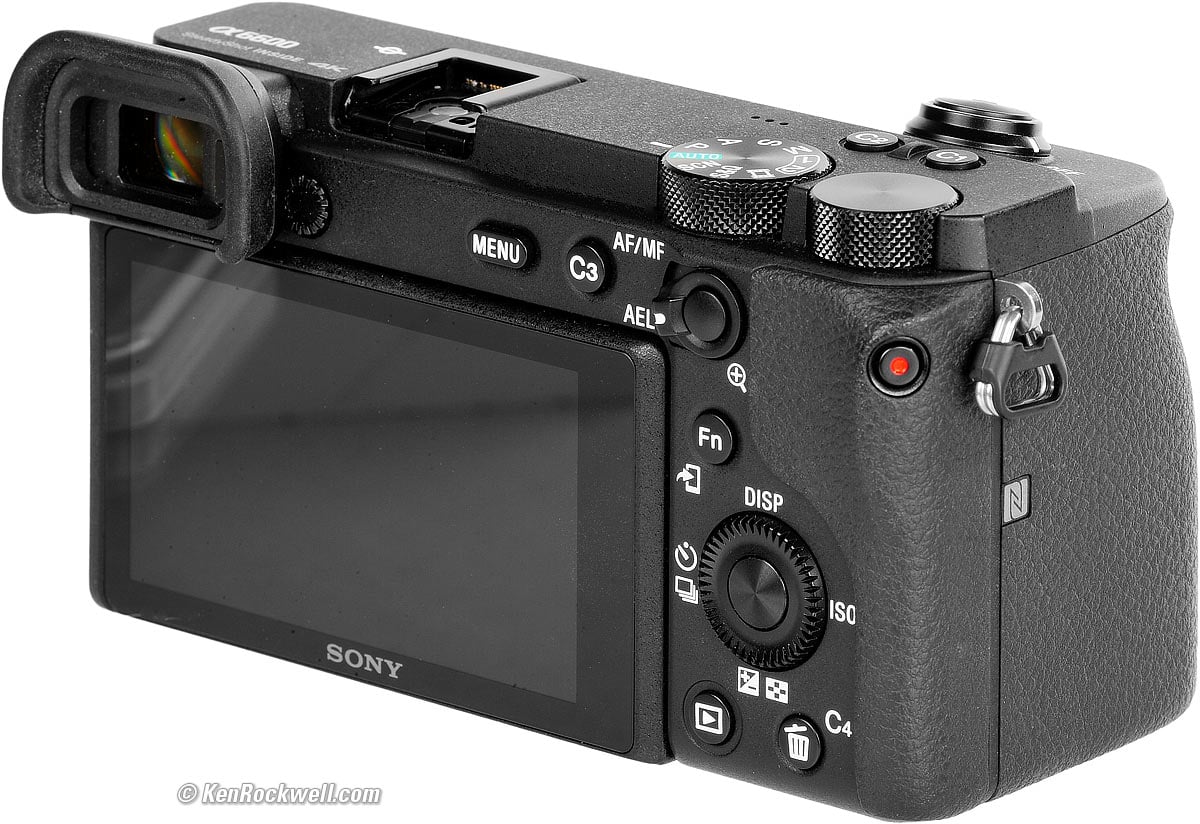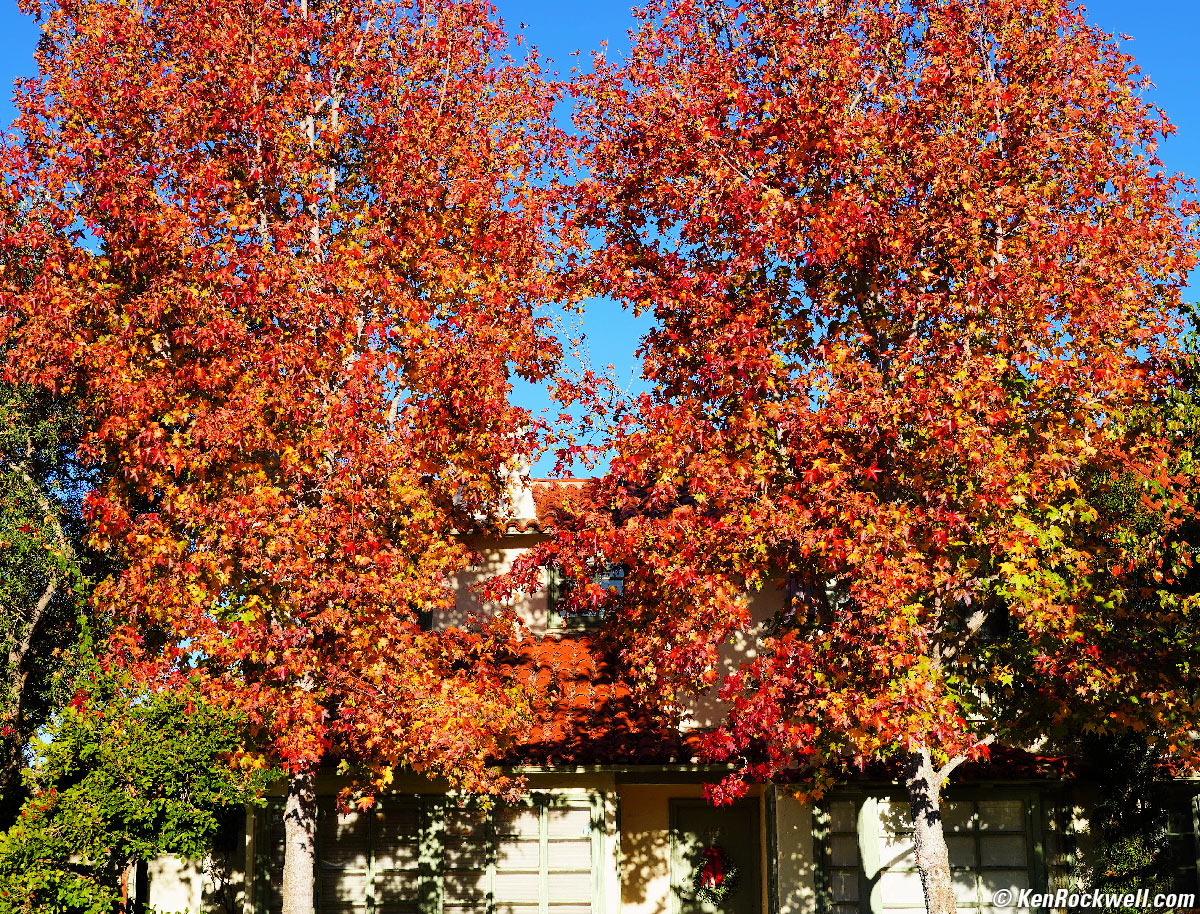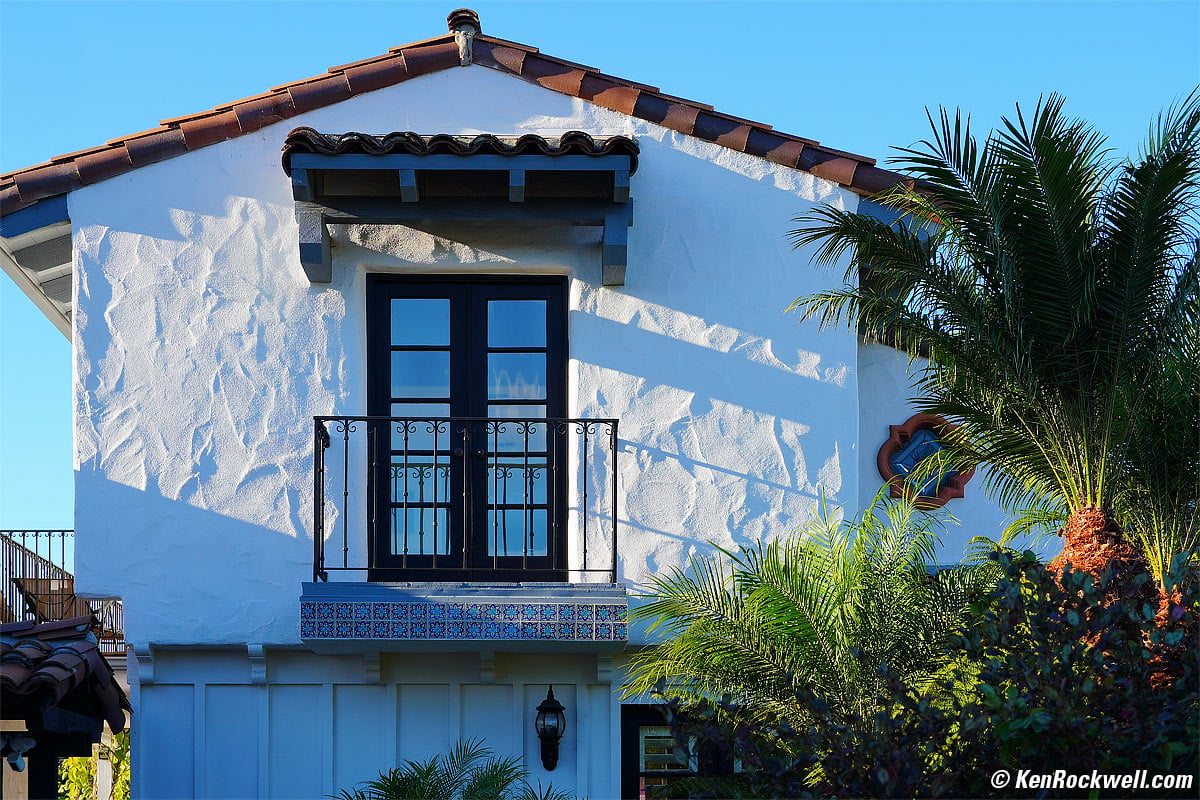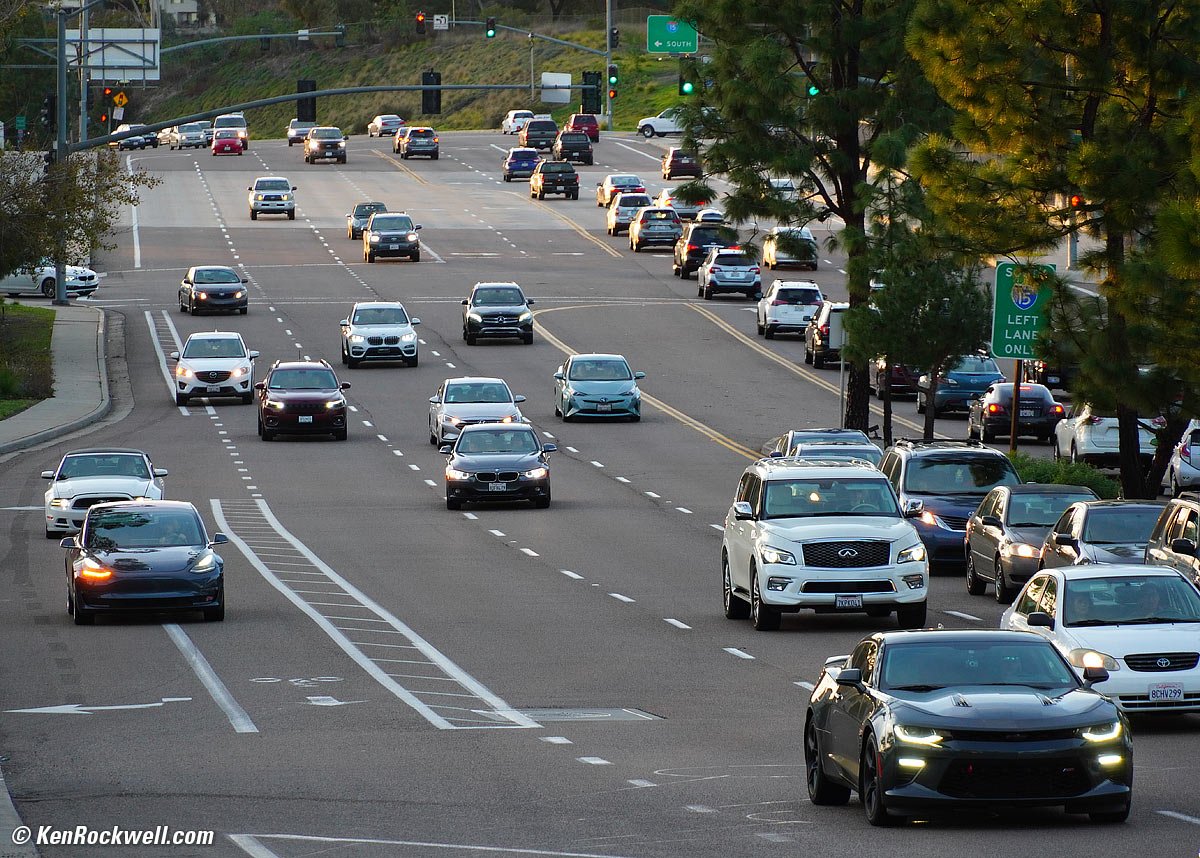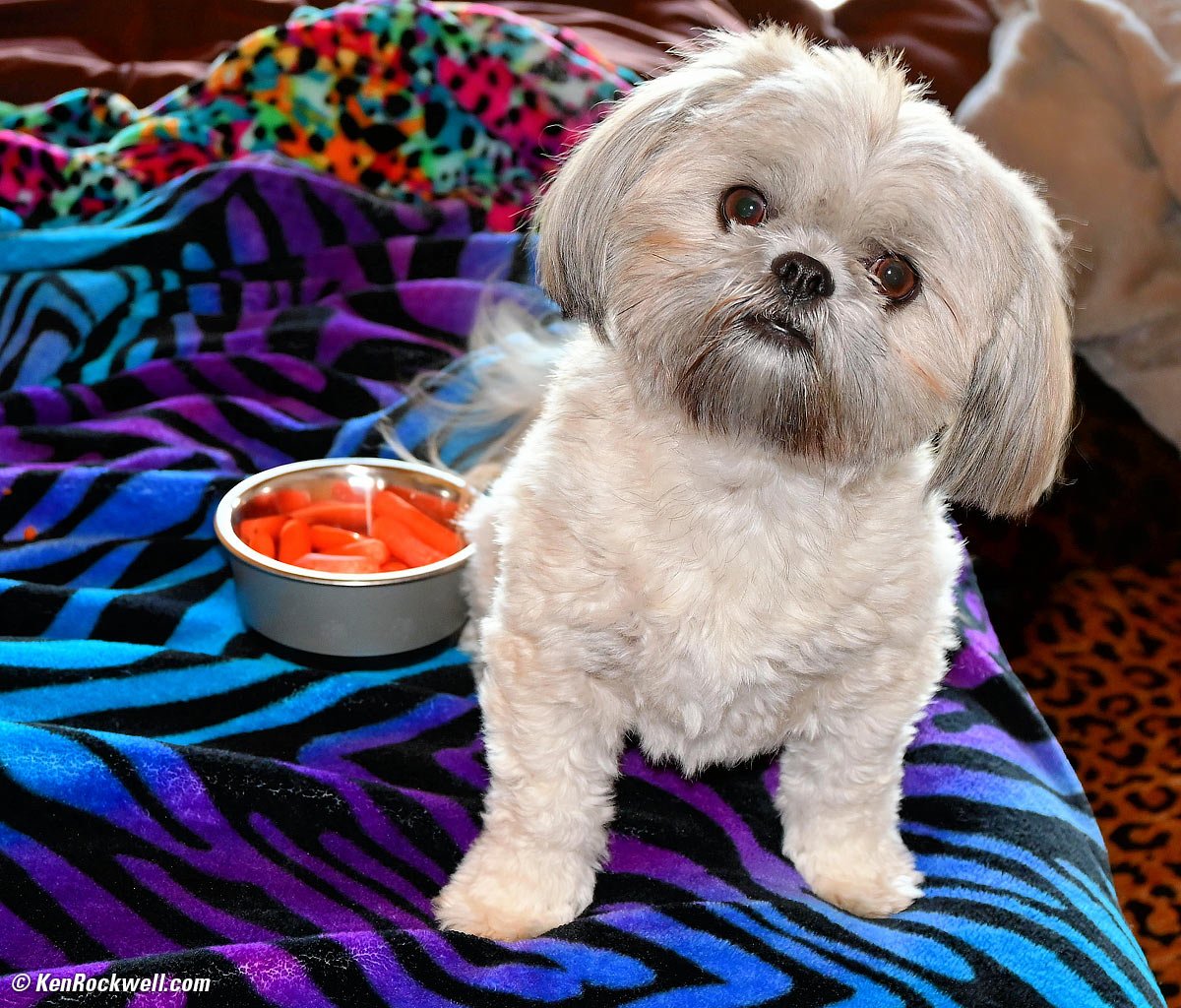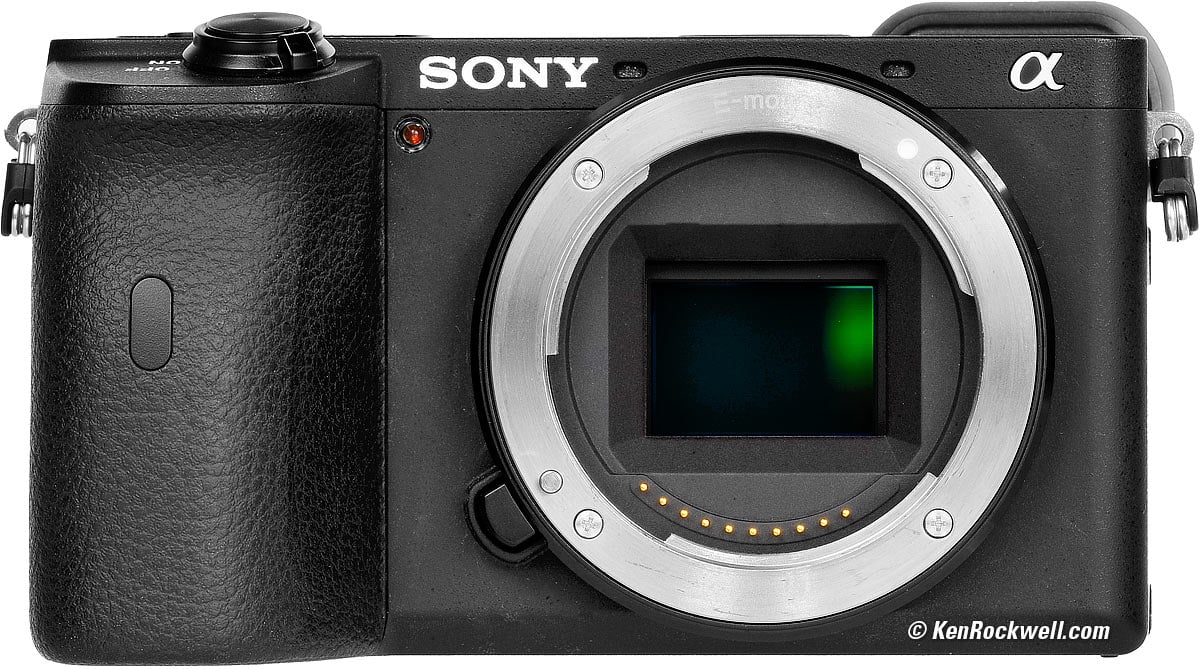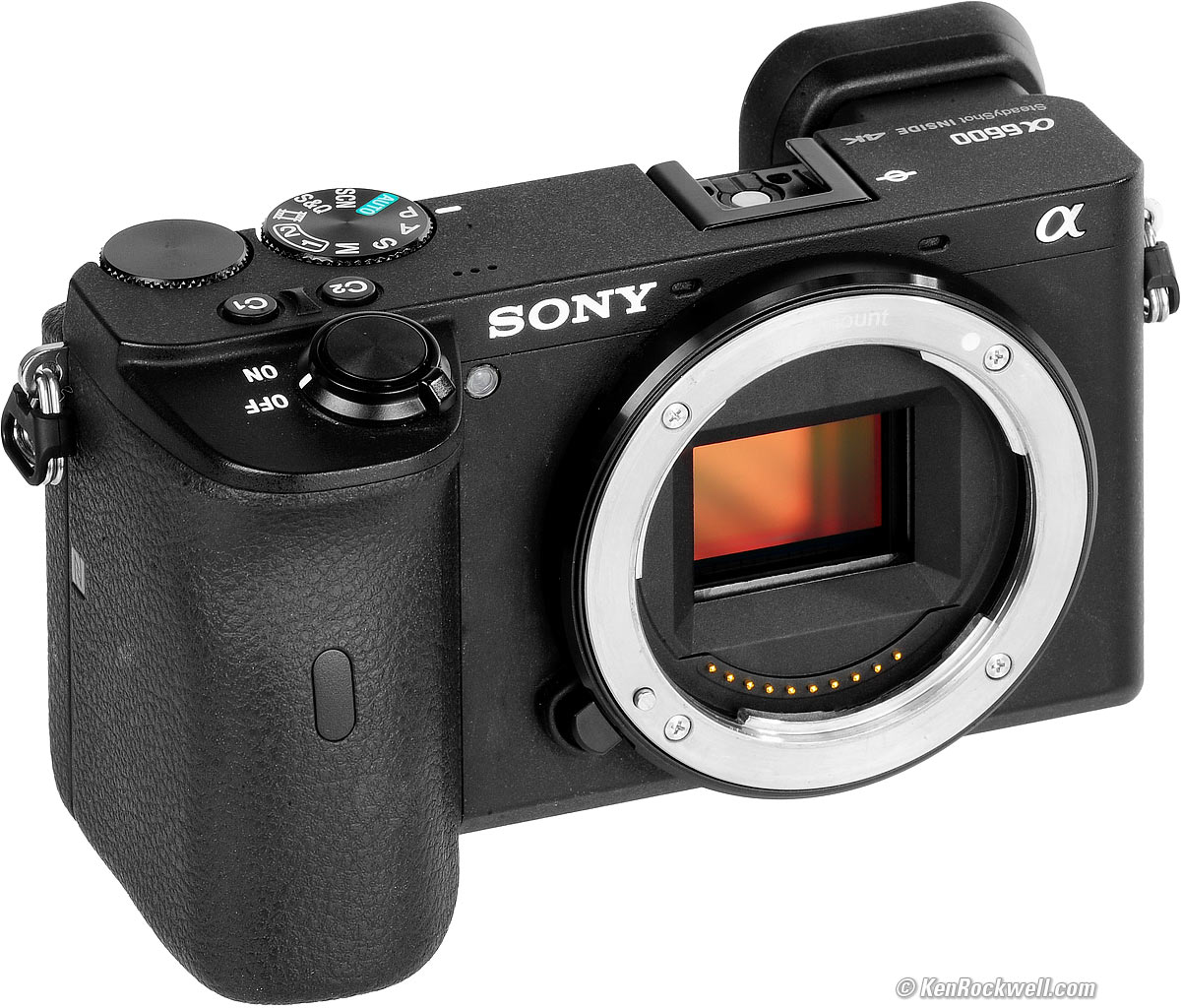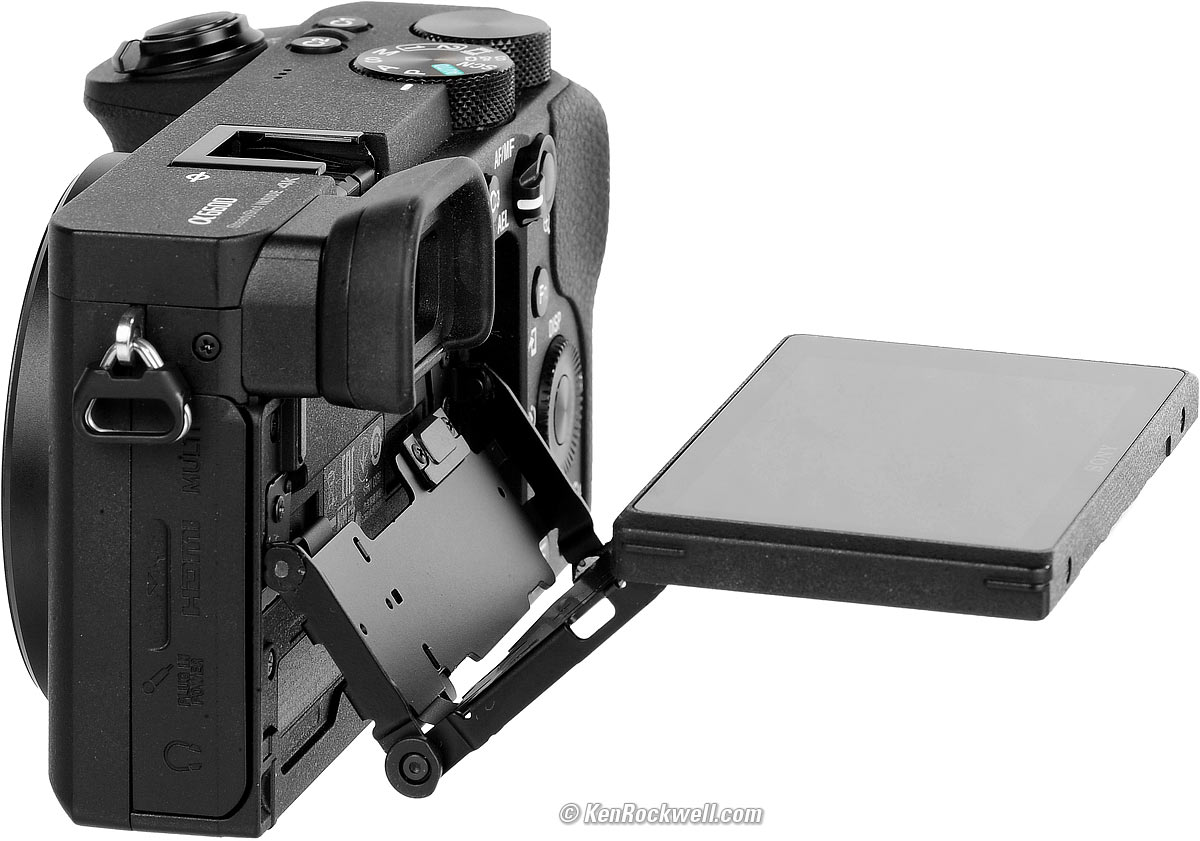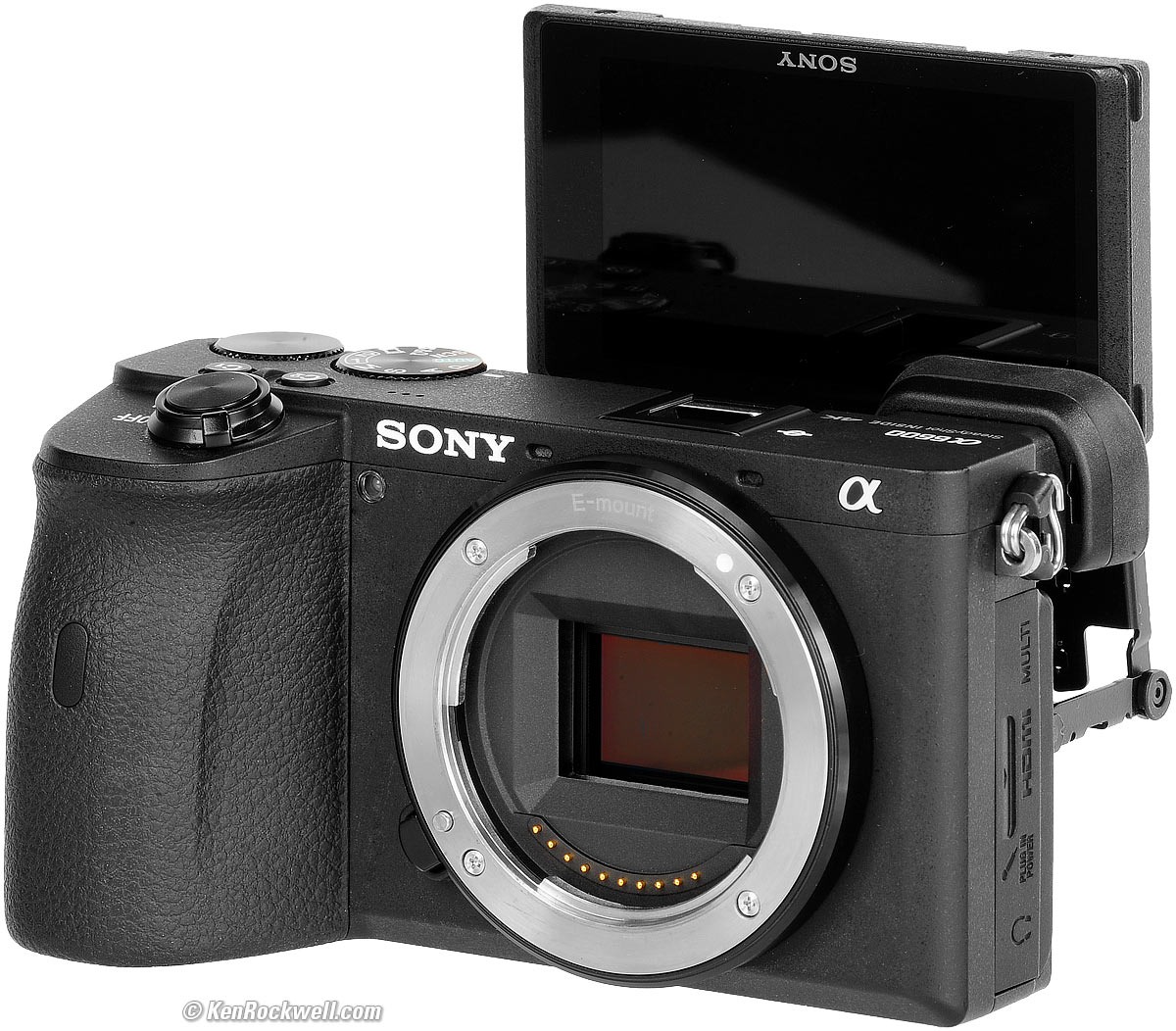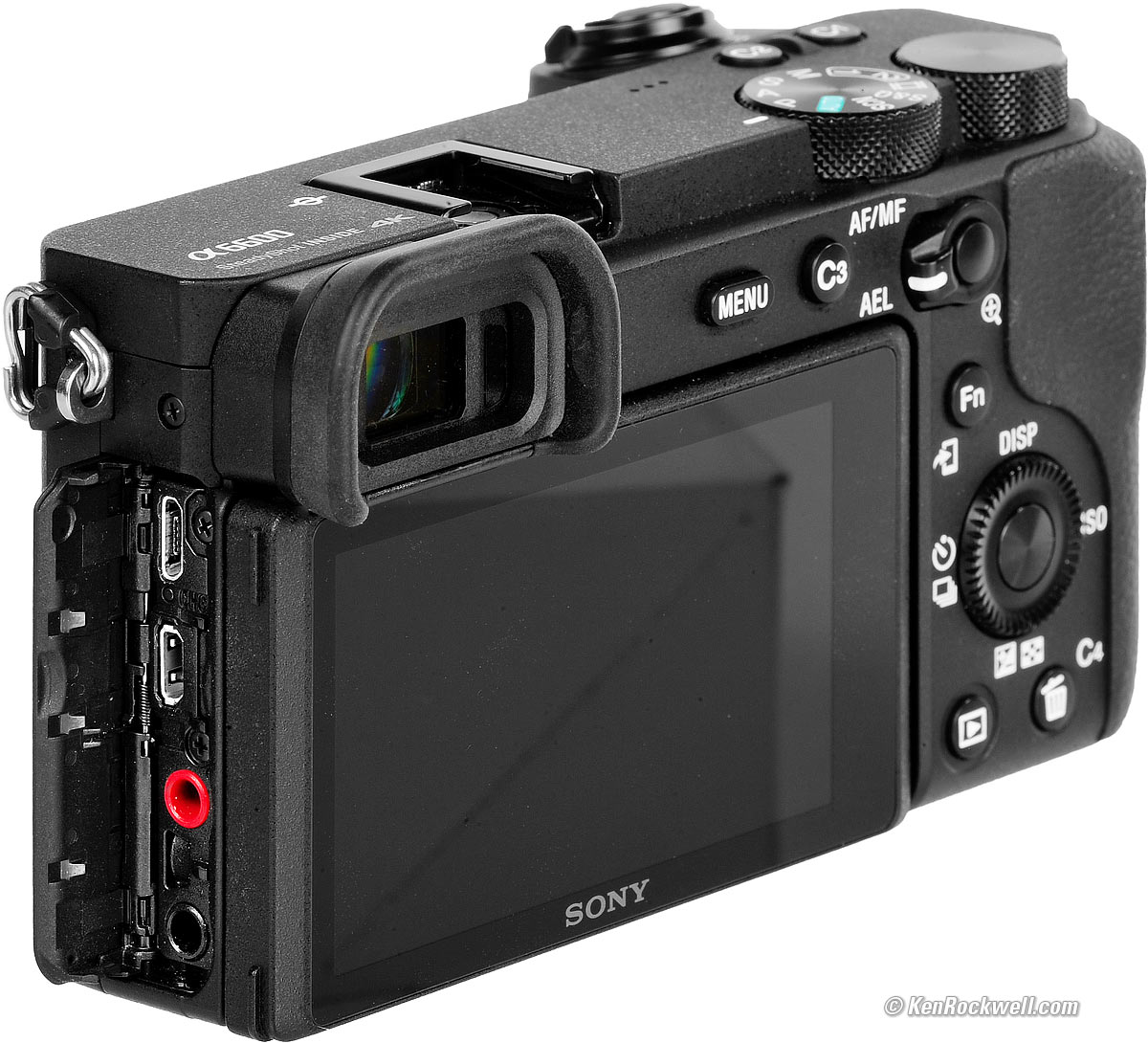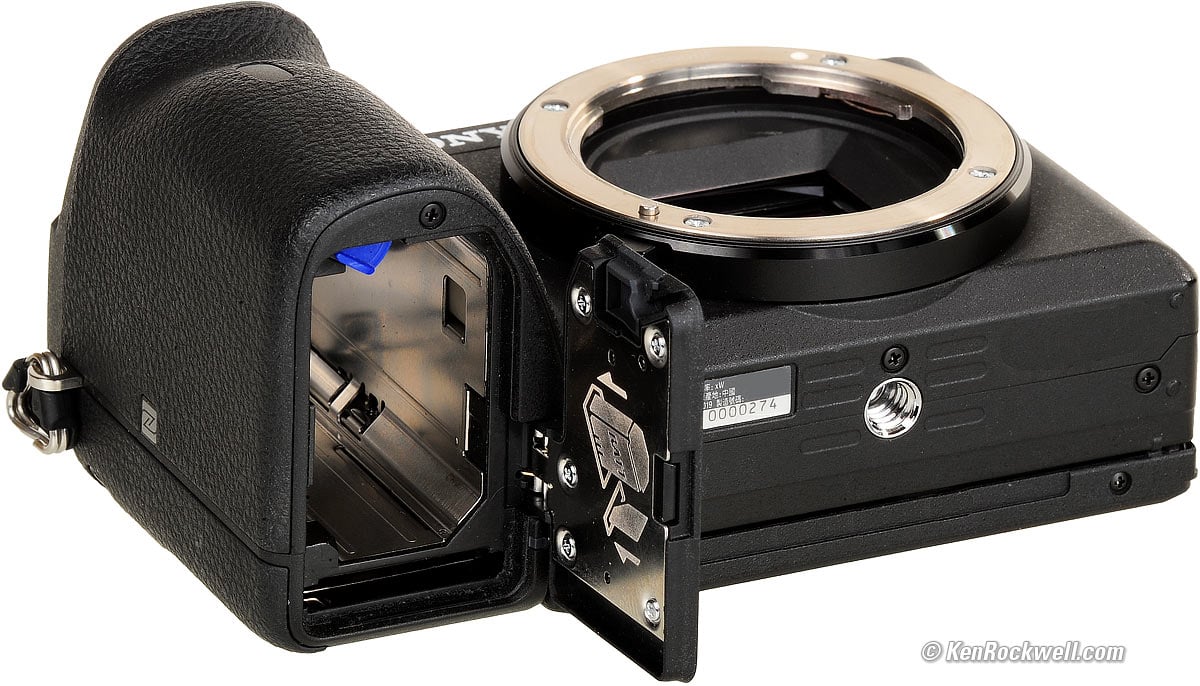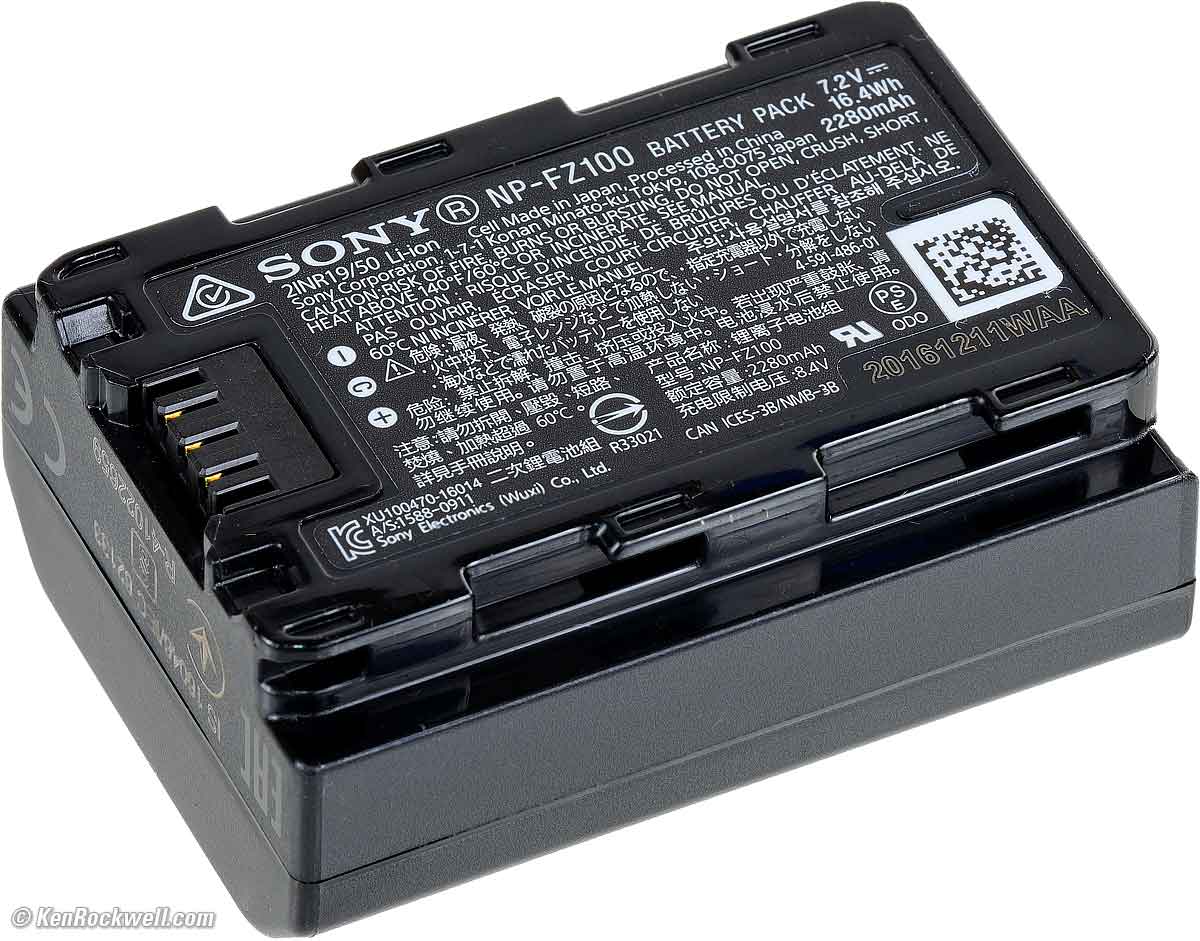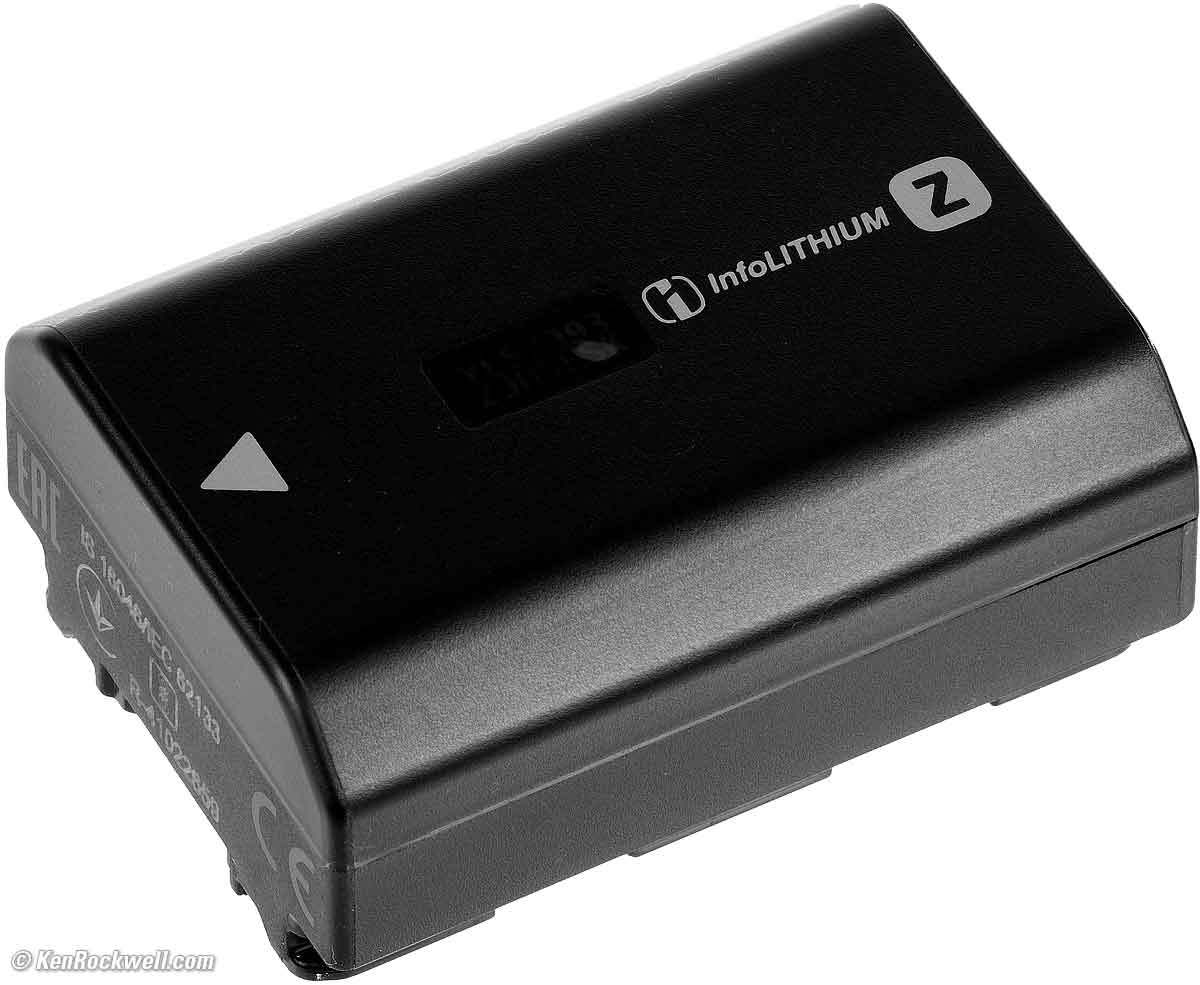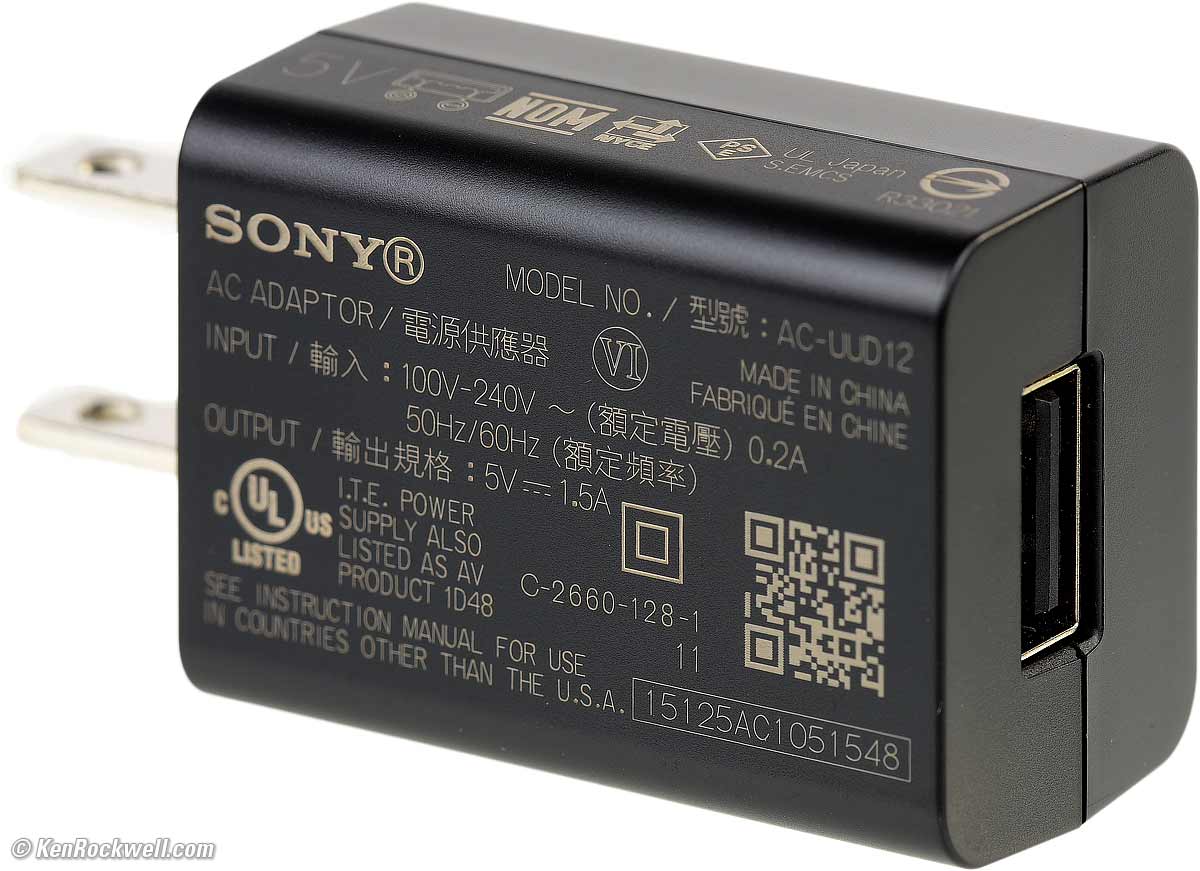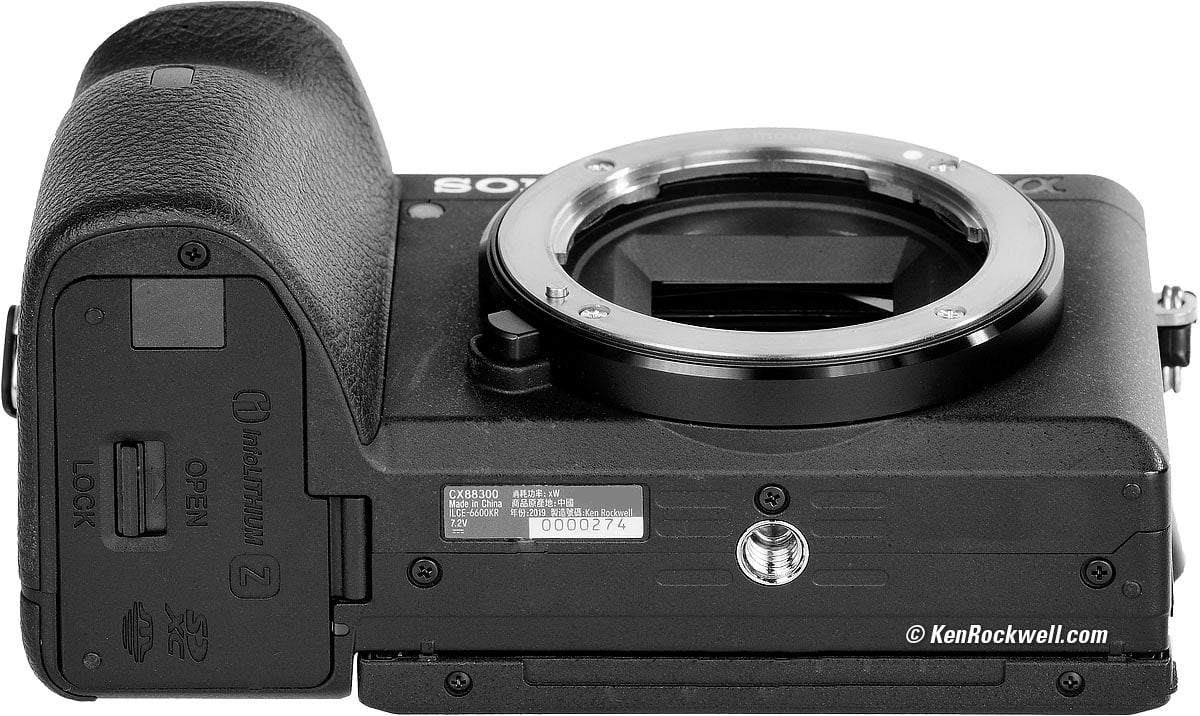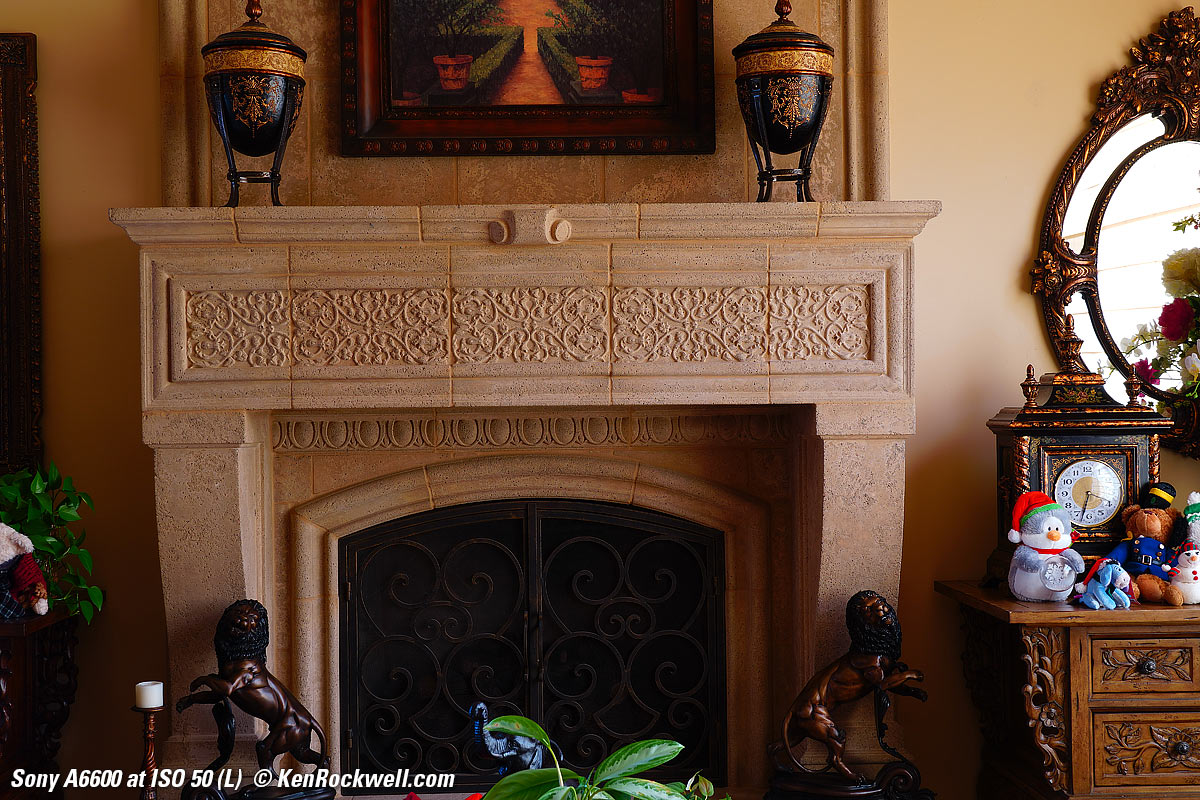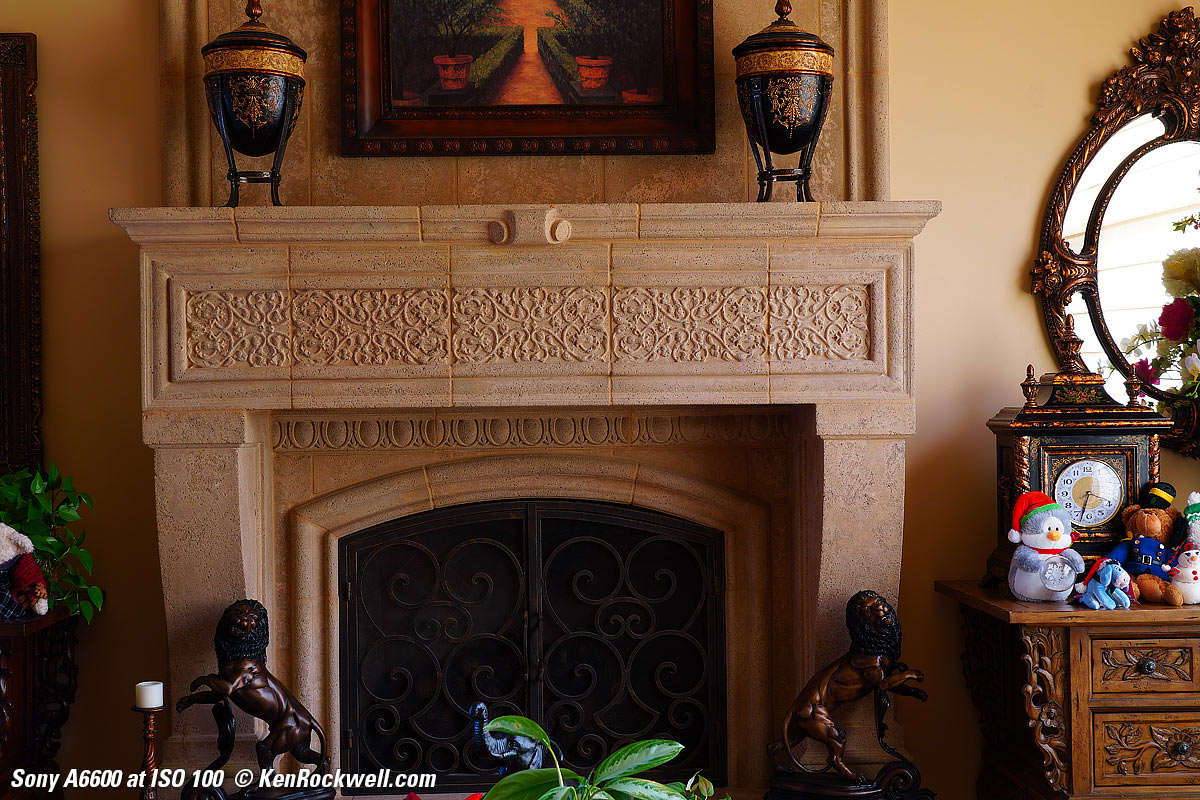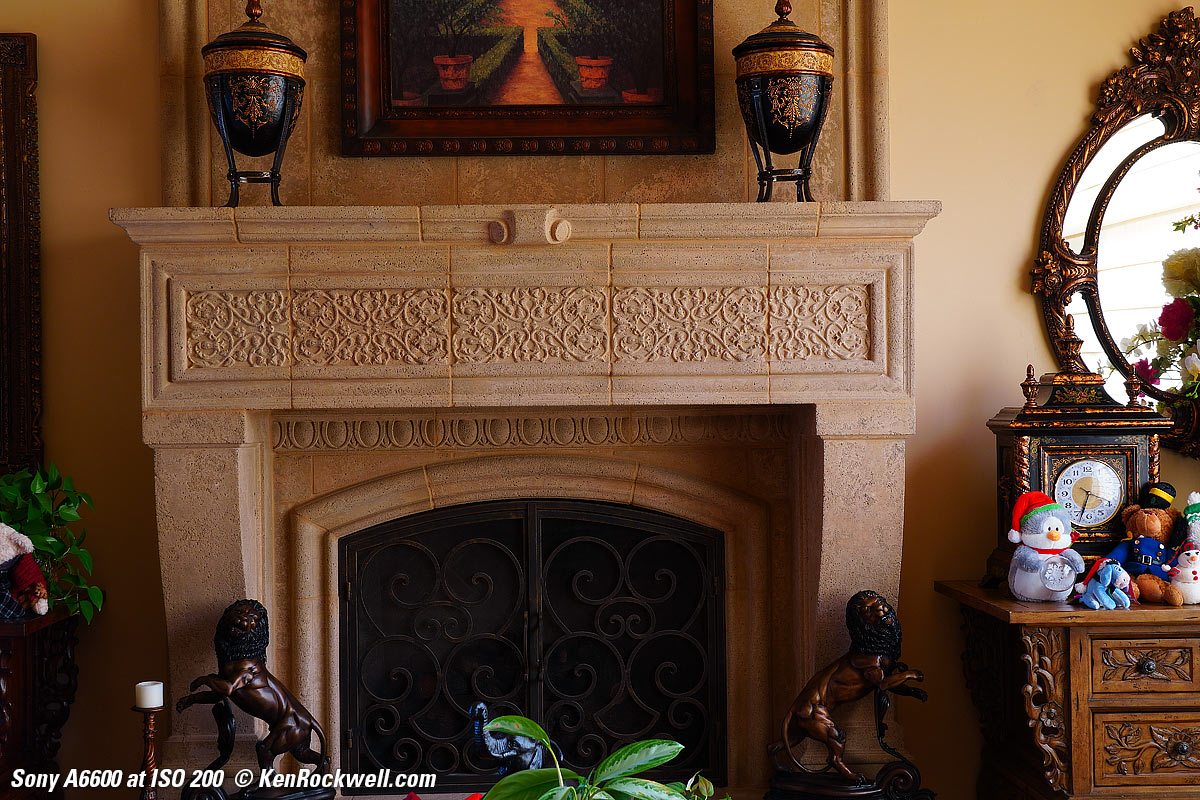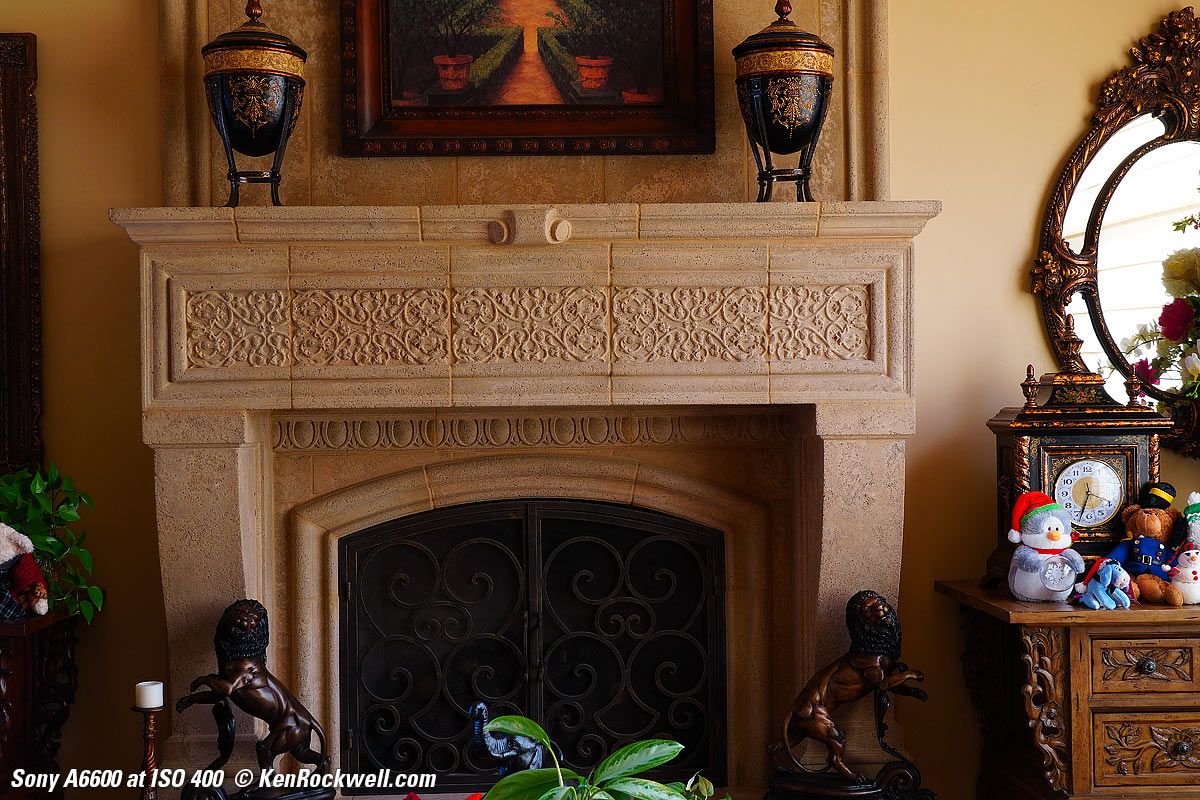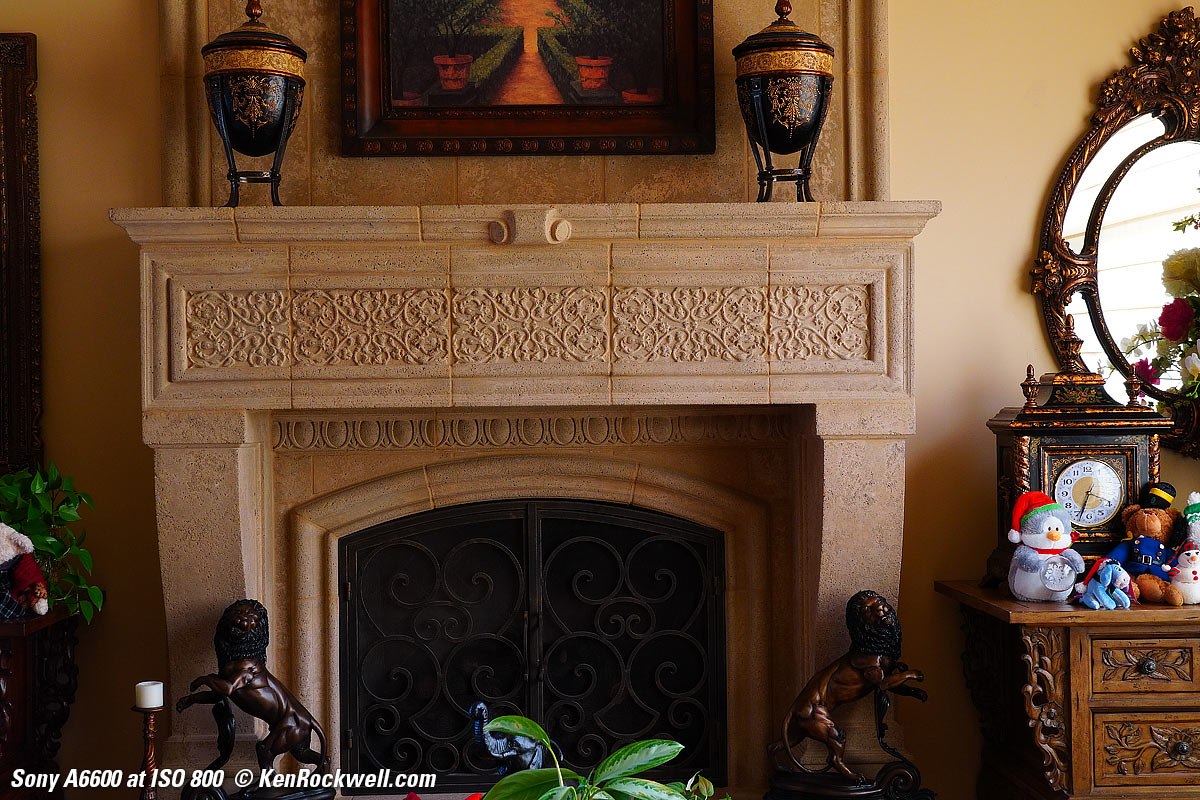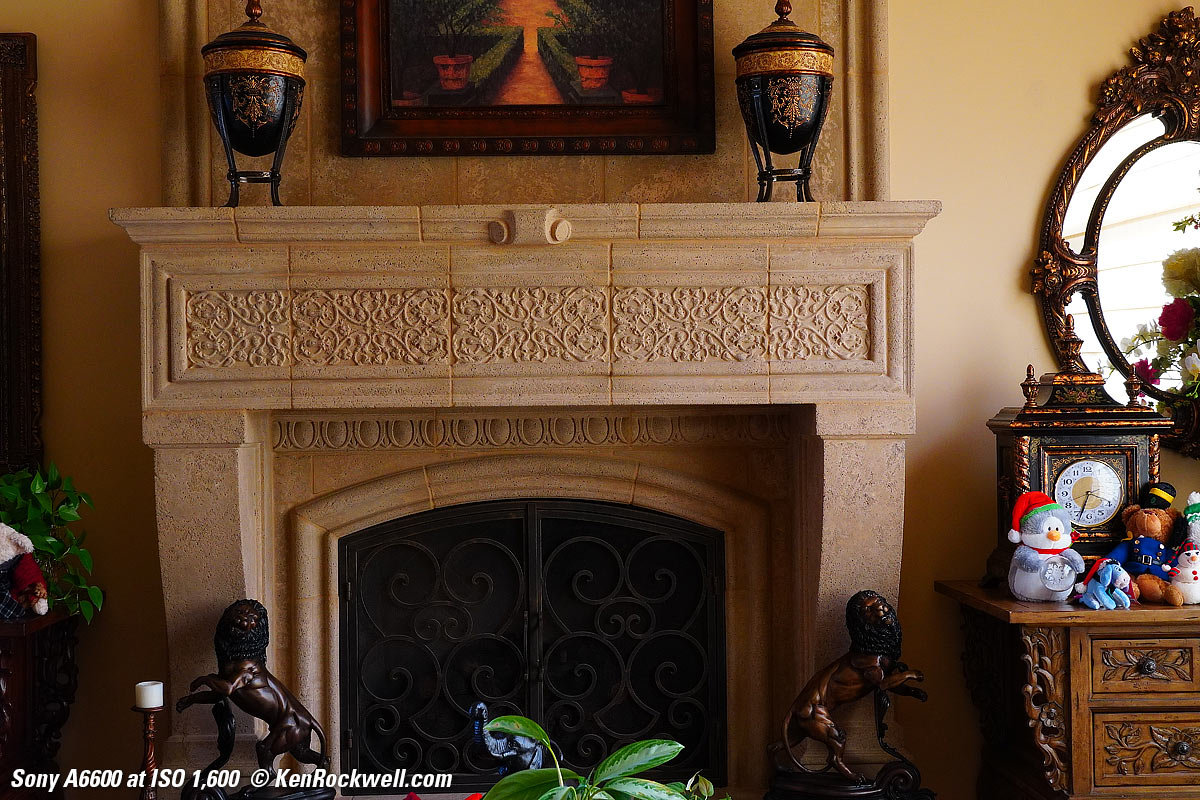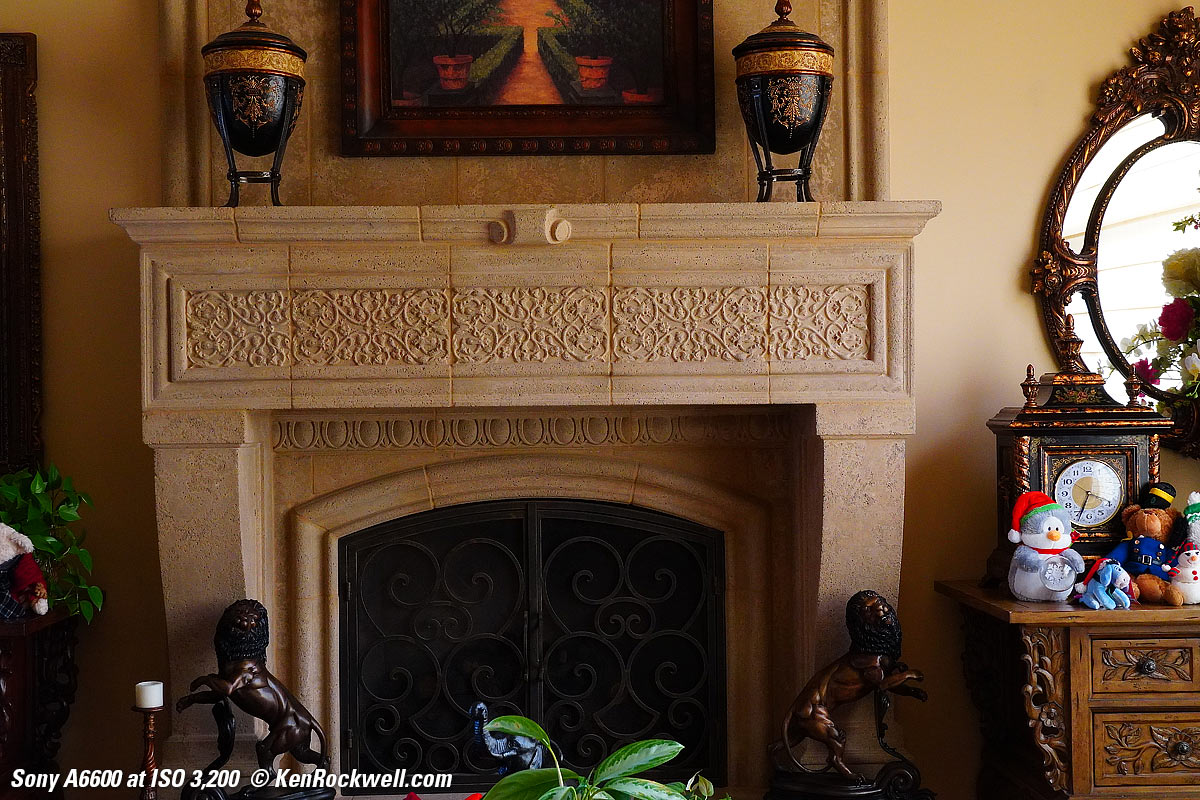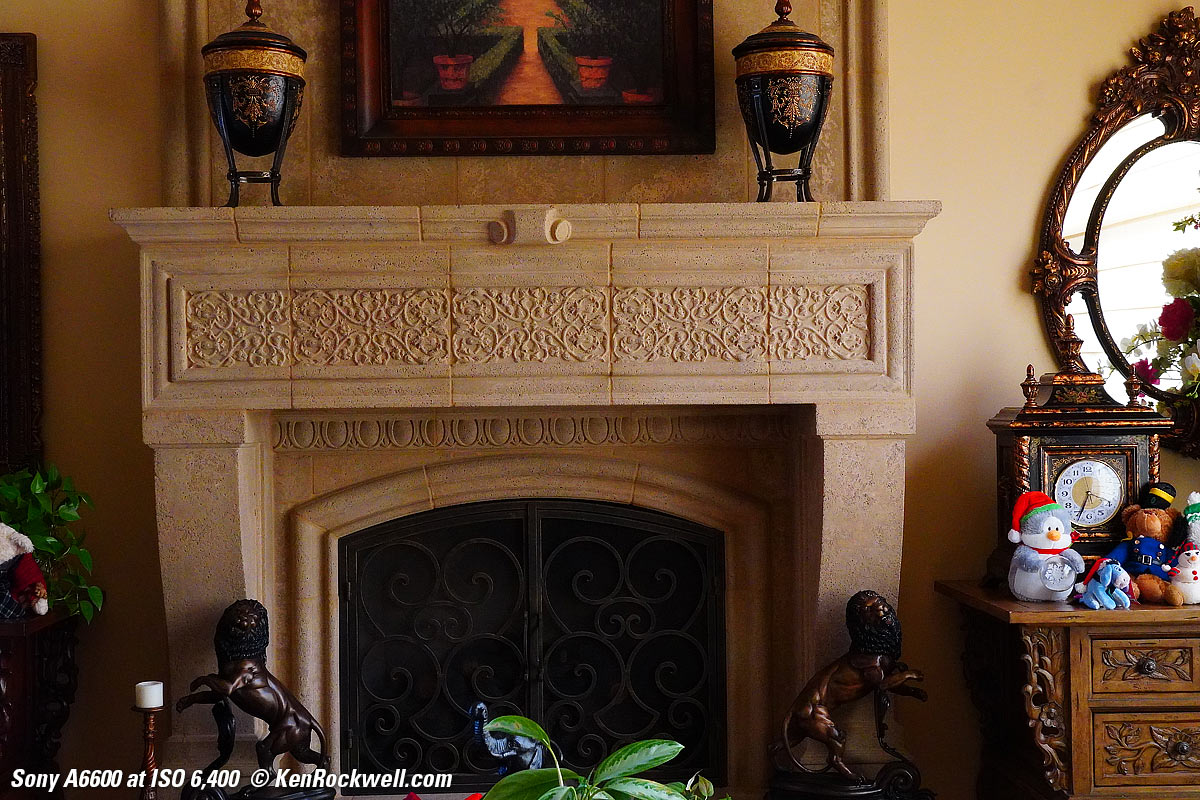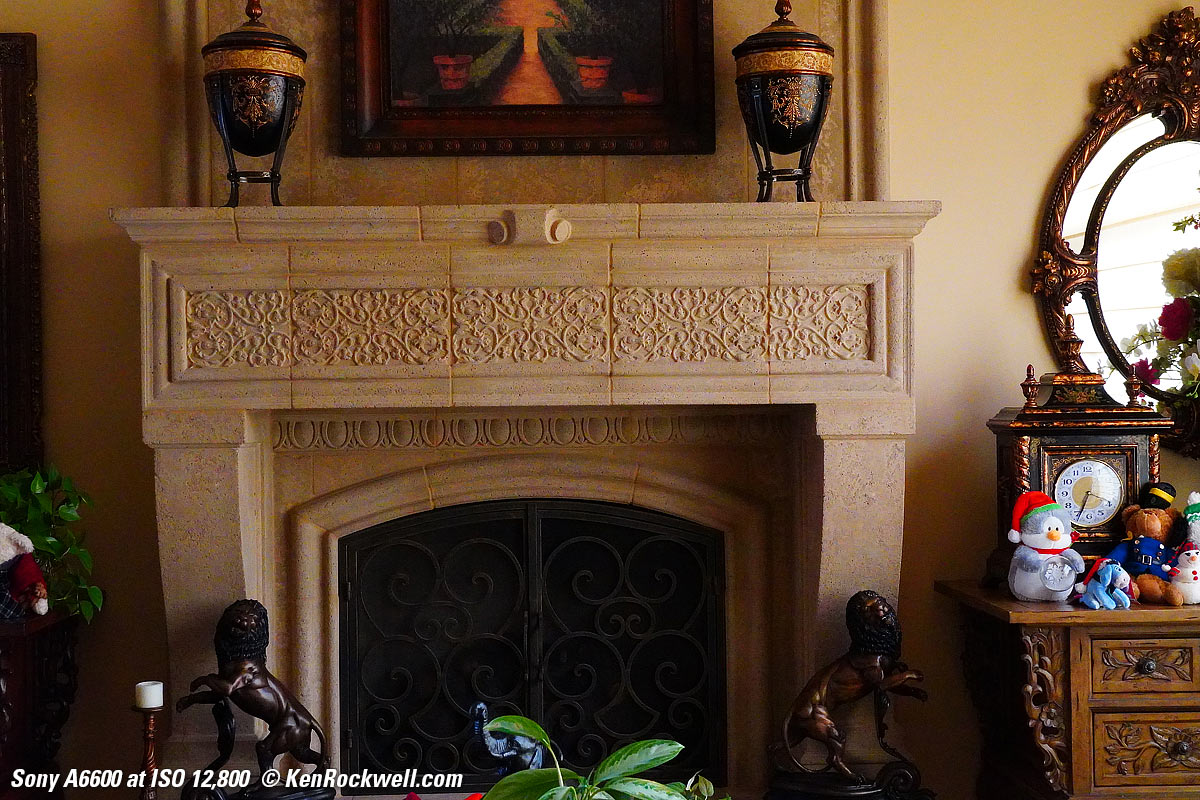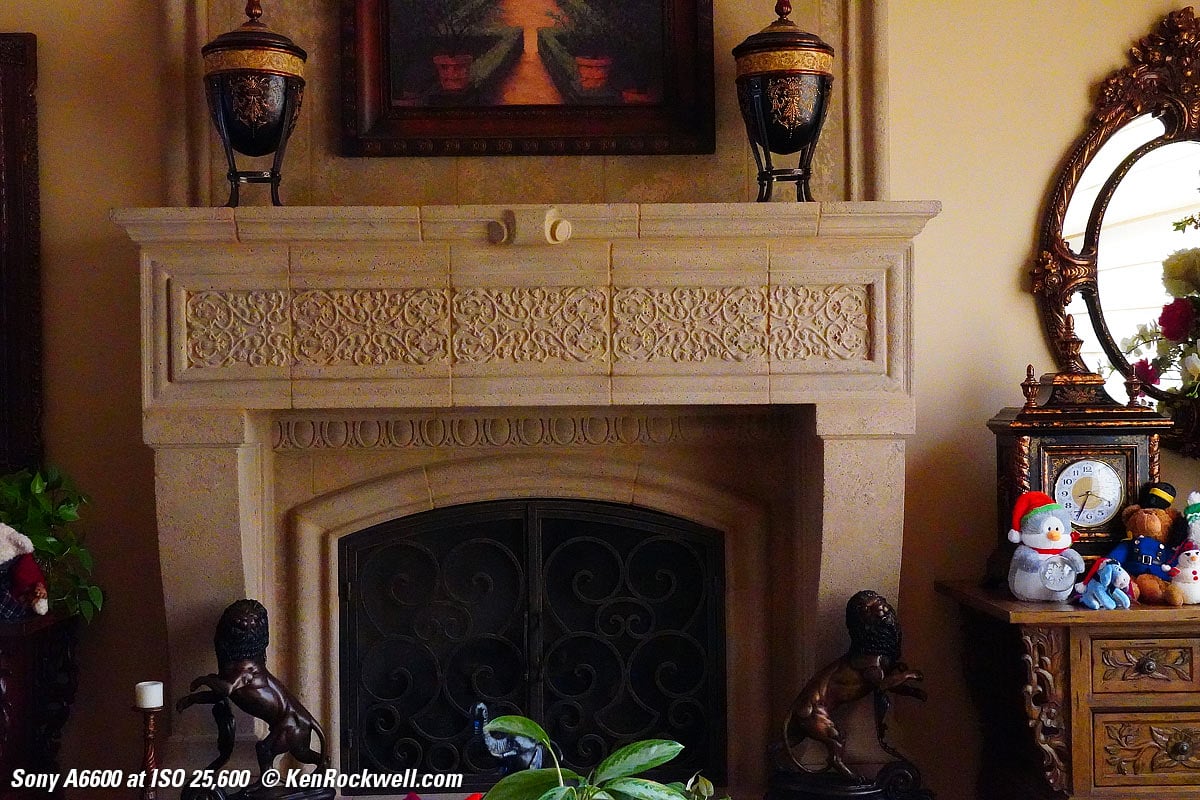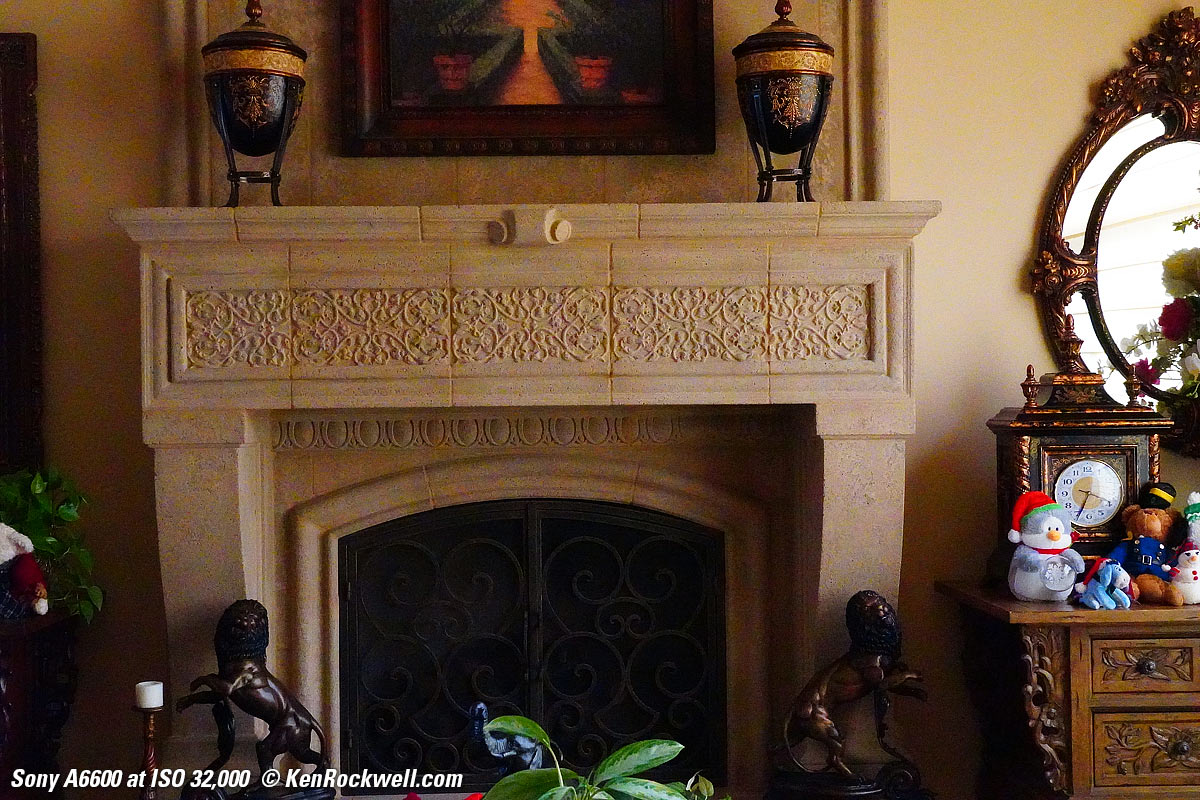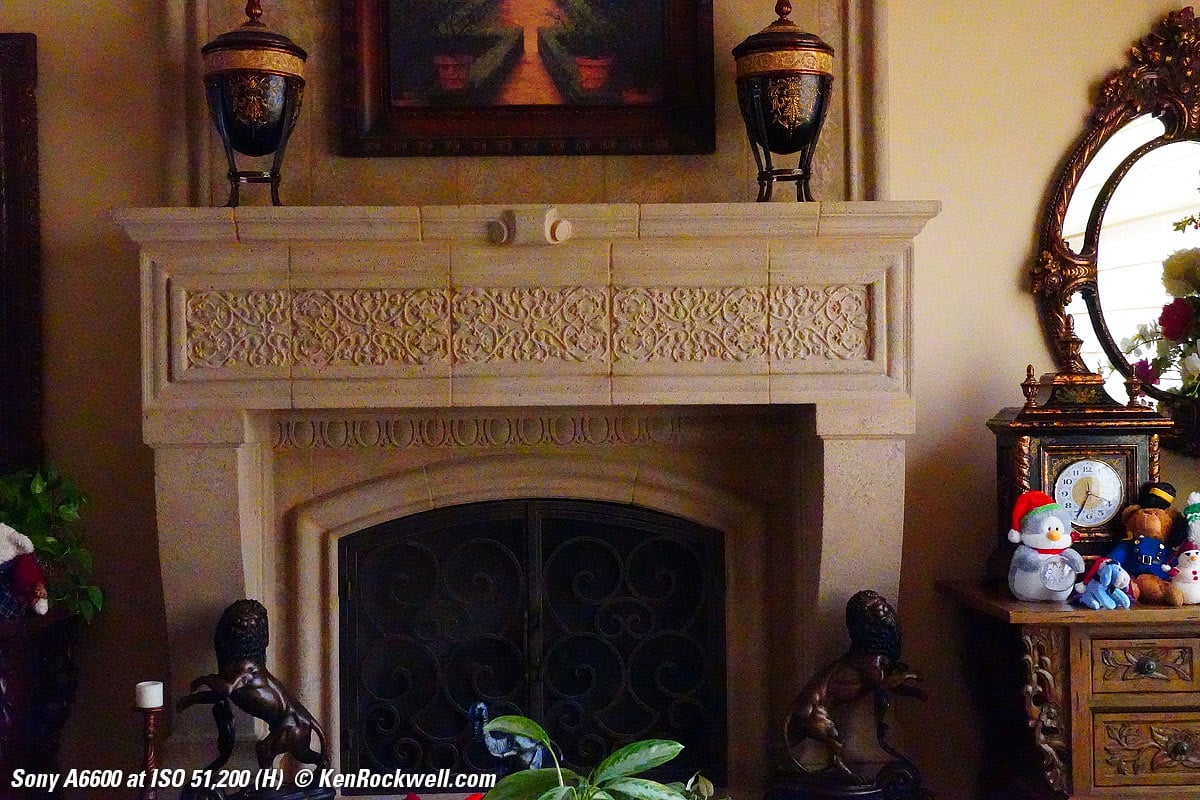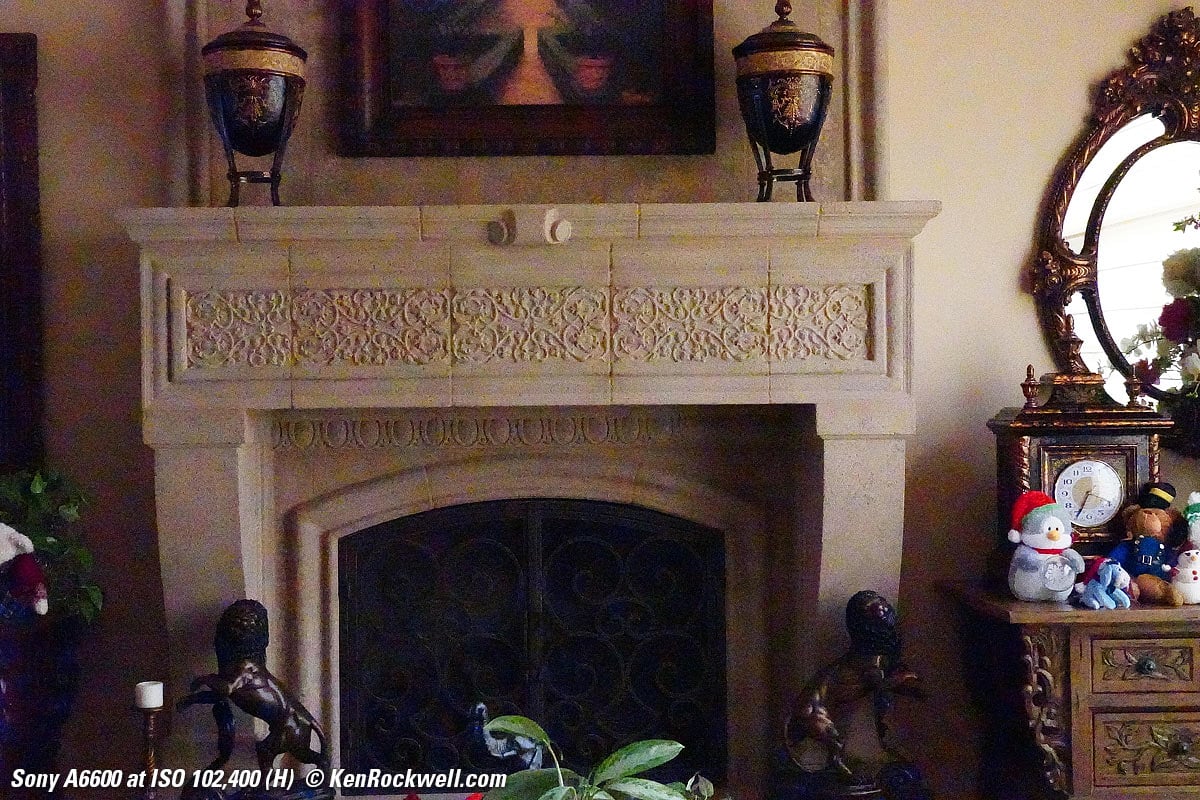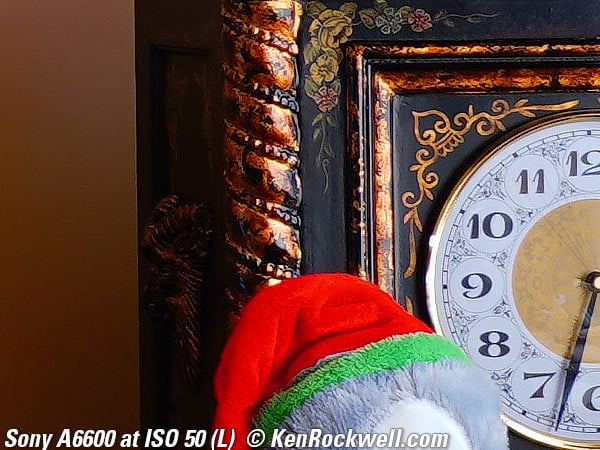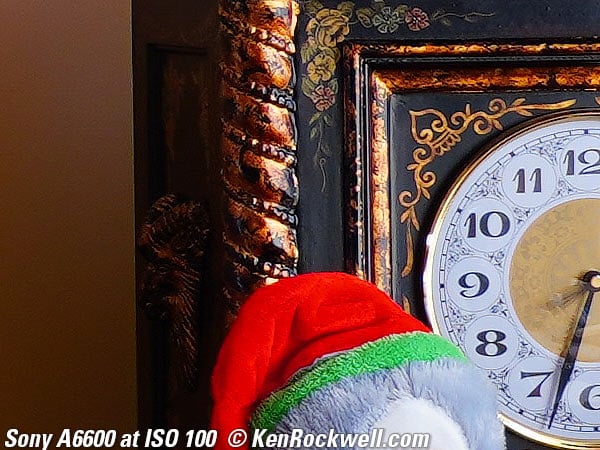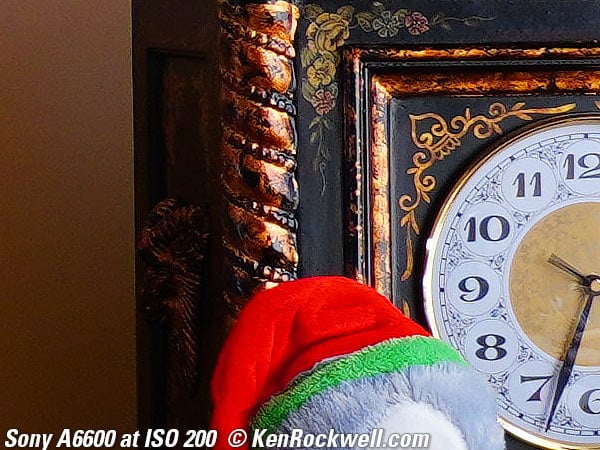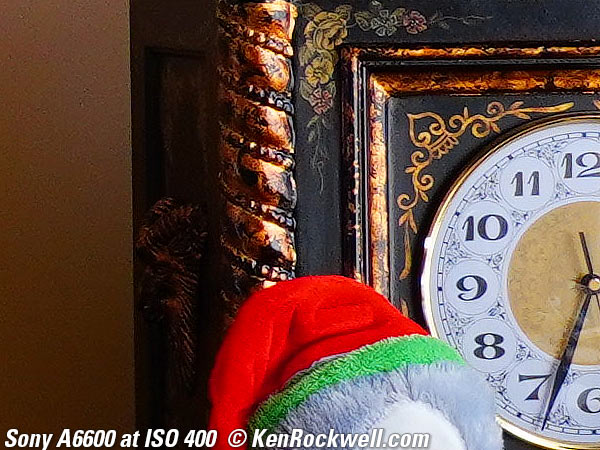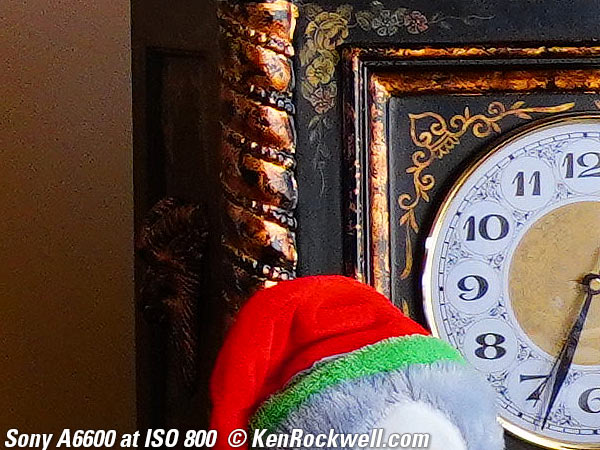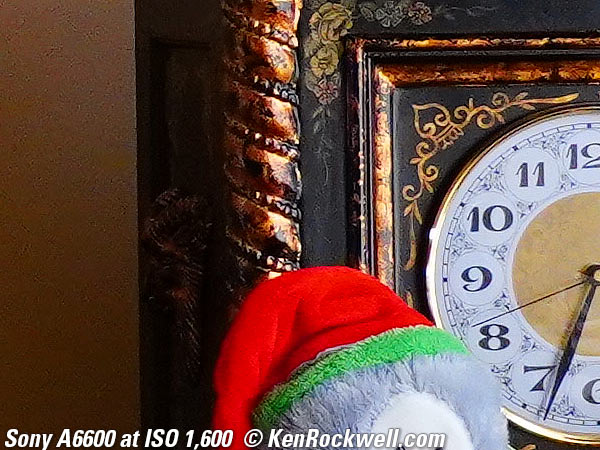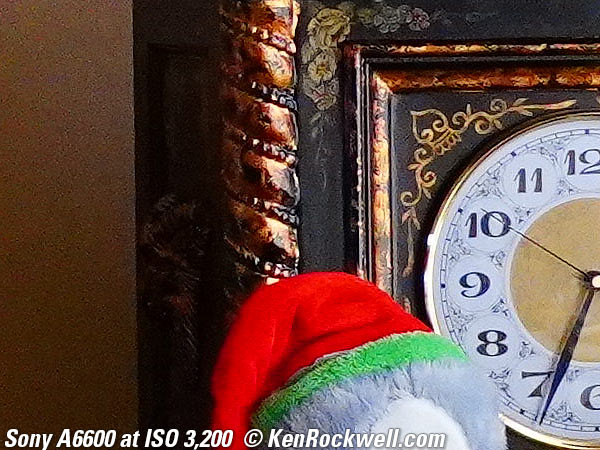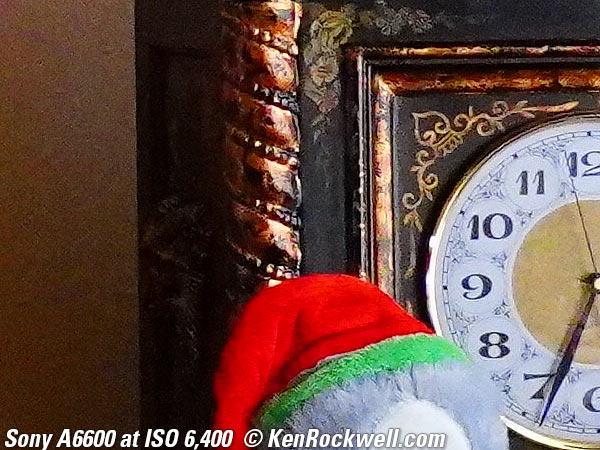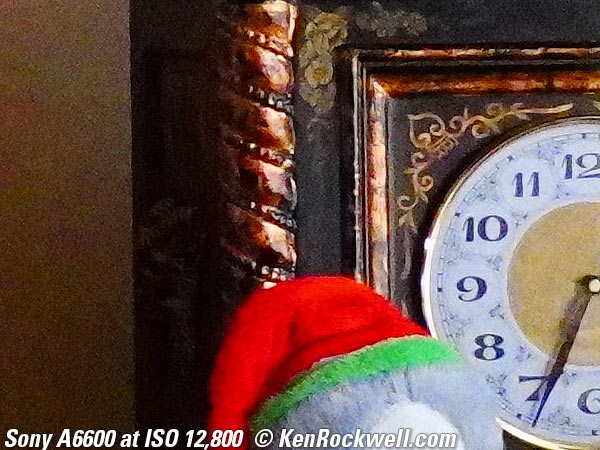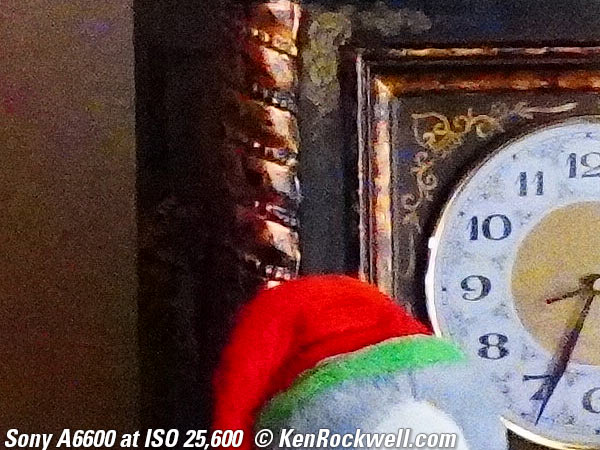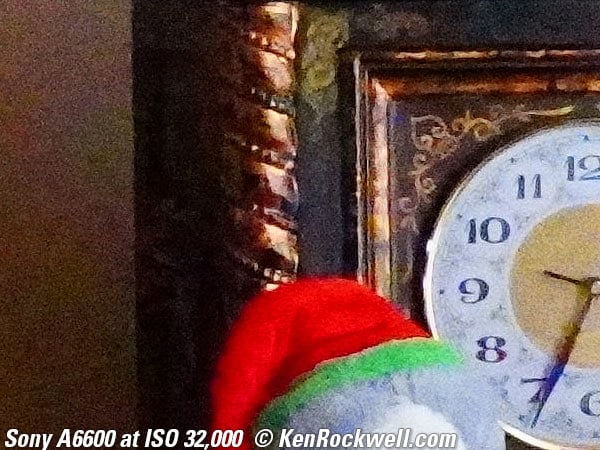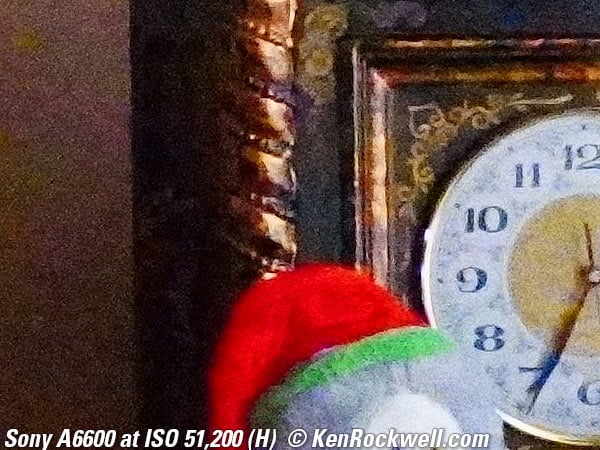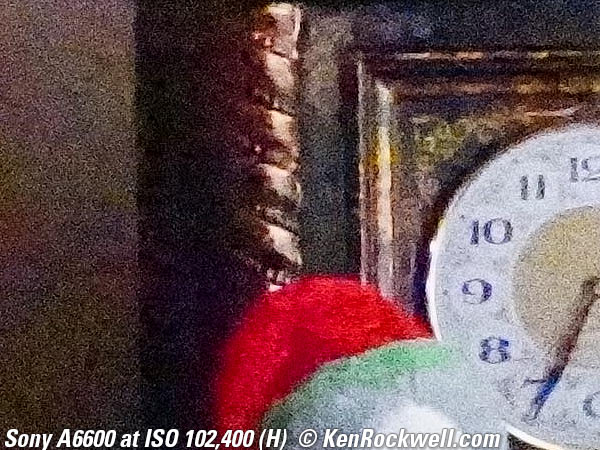Sony A6600
24MP APS-C, 11 FPS, 4K HDR
Sample Images Intro Lenses & Adapters
Specs Legal USA Version Performance
Compared User's Guide Recommendations
Sony: A9 III A1 A9 II A9 A7R V A7R IV A7R III A7 IV A7 III A7R II A7S III A7c A7 II A6600 A6400 A6100 A6000 ZV-E10 RX10/4 RX100/7 RX100/6 Flash Lenses
Sony A6600 (17.7 oz./502g with battery and card, APS-C E-Mount, $1,198) and Sony E 50mm f/1.8 OSS. bigger. I'd get my A6600 body at Adorama, at Amazon, at B&H or at Crutchfield.
It also comes as a kit with the 18-135mm OSS at Adorama, at Amazon, at B&H and at Crutchfield:
Sony A6600 and Sony E 18-135mm OSS. bigger.
This all-content, junk-free website's biggest source of support is when you use those or any of these links to approved sources when you get anything, regardless of the country in which you live. Thanks for helping me help you! Ken.
December 2019 Better Pictures Sony Sony Lenses Zeiss Nikon Canon Fuji LEICA All Reviews
Sony A6500 Review (2016 ~)
Sony A6400 Review (2019 ~)
Sony A6300 Review (2016 ~)
Sony A6100 (2019~)
Sony A6000 Review (2014 ~)
Sony A6600. bigger.
Sony A6600. bigger.
Sony A6600. bigger.
Sample Images top
Sample Images Intro Lenses & Adapters
Specs Legal USA Version Performance
Compared Usage Recommendations
Two Red Trees, 8:24 AM, 20 December 2019. Sony A6600, Sony E 18-135mm OSS at 34mm, f/8 at 1/250 at Auto ISO 100 (LV 14.0), Perfectly Clear v3.) bigger, full-resolution © file or camera-original © file.
Santa Barbara Morning, 8:28 AM, 20 December 2019. Sony A6600, Sony E 18-135mm OSS at 40mm, f/6.3 at 1/160 at Auto ISO 100 (LV12.6), perspective correction in Photoshop CS6, Perfectly Clear v3.) bigger, full-resolution © file or camera-original © file.
The Long Drive Home, 4:19 PM, 20 December 2019. Sony A6600, Sony E 18-135mm OSS at 135mm, f/5.6 at 1/250 at Auto ISO 500 (LV 10.6), as shot.) bigger or camera-original © file.
Introduction top
Sample Images Intro Lenses & Adapters
Specs Legal USA Version Performance
Compared Usage Recommendations
|
I buy only from these approved sources. I can't vouch for ads below. |
The Sony A6600 is a new version of the mostly identical A6500 from 2016, adding a big NP-FZ100 battery with over twice the capacity of the old NP-FW50, but paradoxically removing the critical built-in flash. I'll presume this is as the A6600 is optimized for all kinds of video shooting rather than the still shooting I do.
Without a built-in flash, the only Sony APS-C camera without one, the A6600 takes worse-looking pictures of people, animals and pets under most conditions unless you always have an external flash with you on the camera.
Lighting is the most important technical part of every photo and every painting. Fill flash is a critical part of almost all people, animal and pet pictures made indoors and out, where it gives catchlights in the eyes, makes faces stand out and softens shadows so we can see our subjects and make them look much, much better. Fill flash improves the light and therefore the picture; I don't use flash in pitch dark as the only source of light; that went away decades ago with film.
In these two typical shots below, both under normal backlight, I had no on-camera flash so my little dog's face wound up being in shadow, with dark holes for eyes devoid of life-giving catchlights usually given from a pop-up fill flash:
No Flash: Sad Christmas Zoey Misses the Built-in Flash, 8:01 AM, 21 December 2019. Sony A6600, no flash, Sony E 18-135mm OSS at 108mm, f/5.6 at 1/200 at Auto ISO 1,250 (LV 9.0), Perfectly Clear v3.) bigger or camera-original © file.
With Flash: Happy Zoey and Her Carrots, 7:19 AM, 30 November 2019. Cropped from Nikon Z50 with flash, Nikon Z 16-50mm DX VR at 35mm wide-open at f/5.3 hand-held at 1/15 of a second at Auto ISO 640 (LV 6.0), Perfectly Clear. bigger, full resolution 20MP file or camera-original © JPG file.
With a flash the face lights up, which you want to do to make the person, animal or pet stand out from the background, and the little dots of light reflected in the eyes make the subject look alive. I especially use fill flash in direct sunlight, where it softens and opens up shadows on faces. High ISOs do nothing to help here; the flash improves the quality of light rather than just the quantity.
The A6600 focuses super-fast and otherwise makes great-looking images in just about any light, just like every other A6000 series camera. The biggest reason to pay more for the A7 III or A7R IV is if you need a dedicated exposure compensation dial — but you can assign other command dials to this in the A6600. The full-frame cameras are better if you really need ISOs above 25,600 (you don't) or need more than 24 megapixels, which you don't either.
The biggest difference between APS-C cameras and full-frame is that there's deeper depth-of-field on APS-C, while full-frame systems have shallower depths of field at the same angle-of-view and f/stop. They're all super-sharp and work great at high ISOs; if you prefer smaller size, weight, more in focus and higher frame rates get this A6600; go full-frame if you prefer shallower depth-of-field or want to use old 35mm lenses on adapters.
I really miss the built-in flash, which I use on almost all people, pet and animal pictures, so I wouldn't buy this A6600; I'd prefer any of the almost identical A6000 series which has a flash. I'd rather carry a spare battery instead of going without the built-in flash — but that's just me speaking from knowing what makes pictures look great from over 50 continuous years of shooting experience.
Now that Nikon has a great APS-C camera, the Nikon Z50, which takes better pictures due to better color rendition, is easier to use due to far superior ergonomics, has a built-in flash and costs far less, I'd pass on the A6600 unless you're already fully invested in the Sony system, and even then I'd pass on this A6600 in favor of any other similar Sonys with flash, like the new A6100. This is supposed to be a small camera, and if I need to haul an outboard flash, forget it.
I refer to the A6600, a6600 and α6600 interchangeably; they're the same camera. Sony uses all three designations depending on where you read it.
I'd get my A6600 body at Adorama, at Amazon, at B&H or at Crutchfield. It also comes as a kit with the 18-135mm OSS at Adorama, at Amazon, at B&H and at Crutchfield.
 No more built-in flash, the only Sony APS-C camera without one.
No more built-in flash, the only Sony APS-C camera without one.
 2.3 times longer rated battery life than the A6500: 720 versus 310 shots. In actual use I get about 1,500 shots per charge!
2.3 times longer rated battery life than the A6500: 720 versus 310 shots. In actual use I get about 1,500 shots per charge!
 New square 1:1 crop, as well as native 3:2 and the 16:9 crop of the A6500.
New square 1:1 crop, as well as native 3:2 and the 16:9 crop of the A6500.
 Headphone jack.
Headphone jack.
 LCD now can flip up 180º for self-portraits.
LCD now can flip up 180º for self-portraits.
 Auto ISO now covers ISO 100 ~ ISO 102,400.
Auto ISO now covers ISO 100 ~ ISO 102,400.
 Real-time eye-AF, even in video.
Real-time eye-AF, even in video.
 Eye-AF for people and for animals, but you have to select just one at a time at MENU > CAMERA 1 > page 6/14 > Face/Eye AF Set > Subject Detection > select HUMAN or ANIMAL.
Eye-AF for people and for animals, but you have to select just one at a time at MENU > CAMERA 1 > page 6/14 > Face/Eye AF Set > Subject Detection > select HUMAN or ANIMAL.
 4K HDR video (A6500 does 4K, but not HDR).
4K HDR video (A6500 does 4K, but not HDR).
 S-Log2, S-Log3, HLG and HLG1-3 video.
S-Log2, S-Log3, HLG and HLG1-3 video.
 No more MP4 or 720p video.
No more MP4 or 720p video.
 425 zone contrast detection, up from 169 zones.
425 zone contrast detection, up from 169 zones.
 Card slot moved away from door hinge making the card much easier to reach.
Card slot moved away from door hinge making the card much easier to reach.
 New, deeper eyecup is too hard and pokes my eye socket uncomfortably.
New, deeper eyecup is too hard and pokes my eye socket uncomfortably.
 Panorama mode replaced by S&Q (over- and under-crank movie modes) on top dial.
Panorama mode replaced by S&Q (over- and under-crank movie modes) on top dial.
 1.9 oz. (53g) heavier than the A6500.
1.9 oz. (53g) heavier than the A6500.
 $400 more expensive than the A6500 in December 2019.
$400 more expensive than the A6500 in December 2019.
 My Menu (★) menu.
My Menu (★) menu.
 Now shoots at 7 FPS in Silent mode (MENU > CAMERA 2 > page 4/9 > Silent Shooting). The A6500 only ran at high frame rates in the regular shutter mode. (Both camera run up to 11 FPS in regular shutter mode.)
Now shoots at 7 FPS in Silent mode (MENU > CAMERA 2 > page 4/9 > Silent Shooting). The A6500 only ran at high frame rates in the regular shutter mode. (Both camera run up to 11 FPS in regular shutter mode.)
 The Silent Mode setting is now saved and recalled with the camera Memory Settlings.
The Silent Mode setting is now saved and recalled with the camera Memory Settlings.
 The histograms now lack vertical divisions. No longer are there 1/4 or 1/5 markings between black and white.
The histograms now lack vertical divisions. No longer are there 1/4 or 1/5 markings between black and white.
 Bluetooth v4.1.
Bluetooth v4.1.
 Now offshored to China rather than Thailand like the A6500.
Now offshored to China rather than Thailand like the A6500.
 Otherwise has the same 24MP sensor, same ISO range, same 11 FPS frame rate, same AF system hardware, same viewfinder, same frame rates and same video performance as the A6500. New processing adds more eye recognition to the already superb AF system, but even the oldest A6000 has great autofocus.
Otherwise has the same 24MP sensor, same ISO range, same 11 FPS frame rate, same AF system hardware, same viewfinder, same frame rates and same video performance as the A6500. New processing adds more eye recognition to the already superb AF system, but even the oldest A6000 has great autofocus.
 In-camera image stabilization, rated 5 stops.
In-camera image stabilization, rated 5 stops.
 World's best mirrorless autofocus system, just like other Sonys.
World's best mirrorless autofocus system, just like other Sonys.
 Easy to select the autofocus areas with the touch LCD as you look through the finder.
Easy to select the autofocus areas with the touch LCD as you look through the finder.
 Excellent high frame-rate still images.
Excellent high frame-rate still images.
 Small, light, fast, tough and makes great-looking pictures.
Small, light, fast, tough and makes great-looking pictures.
 Two Memory recall modes on the top dial.
Two Memory recall modes on the top dial.
 Every ISO from ISO 50 ~ ISO 102,400 is selectable in third stops.
Every ISO from ISO 50 ~ ISO 102,400 is selectable in third stops.
 Nice hinged connector door, not a crappy floppy flap like too many other cameras.
Nice hinged connector door, not a crappy floppy flap like too many other cameras.
 Remote control via a phone app.
Remote control via a phone app.
 WiFi & NFC.
WiFi & NFC.
 Completely silent in Silent mode.
Completely silent in Silent mode.
 No built-in flash, the only Sony APS-C camera without one.
No built-in flash, the only Sony APS-C camera without one.
 Crummy ergonomics, menus and handling compared to Canon and Nikon APS-C mirrorless cameras. Sony no longer has this market to itself anymore.
Crummy ergonomics, menus and handling compared to Canon and Nikon APS-C mirrorless cameras. Sony no longer has this market to itself anymore.
 Slower handing than a DSLR; still need to wait a moment to turn-on, wake-up or change settings.
Slower handing than a DSLR; still need to wait a moment to turn-on, wake-up or change settings.
 Flash and Bulb modes don't work in Silent mode (they don't on any other camera, either).
Flash and Bulb modes don't work in Silent mode (they don't on any other camera, either).
 LCD is too dim for daylight, too small to show pictures as well as any iPhone, and doesn't flip very far.
LCD is too dim for daylight, too small to show pictures as well as any iPhone, and doesn't flip very far.
 Offshored to China; not made domestically in Japan.
Offshored to China; not made domestically in Japan.
 Chopped 16:9 LCD makes for very small (only 2.6"/66mm) effective image diagonal for 3:2 still images.
Chopped 16:9 LCD makes for very small (only 2.6"/66mm) effective image diagonal for 3:2 still images.
 No built-in flash, the only Sony APS-C camera without one.
No built-in flash, the only Sony APS-C camera without one.
 The touch LCD is great for selecting AF areas, but it doesn't work in menus, doesn't work in playback and especially doesn't work for entering text in the menu system for copyright data — you still have to do all this with the 4-way controller like it's 1978 all over again.
The touch LCD is great for selecting AF areas, but it doesn't work in menus, doesn't work in playback and especially doesn't work for entering text in the menu system for copyright data — you still have to do all this with the 4-way controller like it's 1978 all over again.
 No front control dial; but has a second rear dial which is also the 4-way controller.
No front control dial; but has a second rear dial which is also the 4-way controller.
 No GPS.
No GPS.
 No exposure compensation dial (you can assign the rear dial to this, or you have to fiddle in a menu).
No exposure compensation dial (you can assign the rear dial to this, or you have to fiddle in a menu).
 No way to back up the complete camera state as Nikons can do.
No way to back up the complete camera state as Nikons can do.
 Programmable Memory recall modes don't recall everything, for instance, the memory modes don't save and recall whether or not you're in Silent mode.
Programmable Memory recall modes don't recall everything, for instance, the memory modes don't save and recall whether or not you're in Silent mode.
 No second card slot.
No second card slot.
 The LCD isn't bright enough to see in direct sunlight.
The LCD isn't bright enough to see in direct sunlight.
 The histograms lack vertical divisions. No longer are there 1/4 or 1/5 markings between black and white.
The histograms lack vertical divisions. No longer are there 1/4 or 1/5 markings between black and white.
 No LCD auto brightness control — but the finder's auto brightness control is excellent.
No LCD auto brightness control — but the finder's auto brightness control is excellent.
 No NTSC, no PAL, no MP4 and no 720p video.
No NTSC, no PAL, no MP4 and no 720p video.
Lens Compatibility and Adapters top
Sample Images Intro Lenses & Adapters
Specs Legal USA Version Performance
Compared Usage Recommendations
I'd get my A6600 body at Adorama, at Amazon, at B&H or at Crutchfield. It also comes as a kit with the 18-135mm OSS at Adorama, at Amazon, at B&H and at Crutchfield.
Lens Compatibility
Sony A6600. bigger.
The A6600 uses the Sony E-Mount, first seen on the NEX cameras. Sony sells its own lenses and Zeiss lenses that are native to this mount.
All full-frame FE and APS-C E-mount lenses work great as well.
Lens Adapters
Native Sony & Minolta Adapters
The Sony LA-EA4 adapter lets Sony Alpha and Minolta MAXXUM lenses work flawlessly, with super fast AF and 100% data and exposure automation compatibility.
While the Alpha and MAXXUM SLR lenses lack the optical quality of the latest Zeiss E and FE lenses, they do work very, very well.
Since this is an APS-C camera and those SLR lenses are full frame I'd not bother with this adapter, unless you have a pro-level tele zoom like the MAXXUM 80-200mm f/2.8 or a macro like the MAXXUM 50/2.8 or MAXXUM 100/2.8.
Other Brand Adapters
The biggest gotcha with the Sony system is that there are very few native lenses for it, and most of Sony's and Minolta's lenses aren't that great; Zeiss, Canon and Nikon make better lenses.
While you can adapt any lens to the A6600, they won't work as well as native Sony or Zeiss FE lenses, or Alpha or MAXXUM lenses with the LA-EA4 adapter.
This great little camera becomes a clunky contraption once you add an adapter. The thing may or may not work that well, and probably won't give you anywhere near the resolution you thought you wanted unless you use the native Zeiss lenses.
Forget LEICA, Nikon or other old manual focus lenses; you'll have to open and close the diaphragm completely manually for each frame!
The best non-native solution is to use a decent Canon EOS to NEX adapter and you'll get full autofocus, auto exposure, EXIF data and diaphragm operation with every Canon lens made since 1987.
Better, with a Canon adapter you can use a real man's lens like the Canon 50mm f/1 for great results in starlight. The Canon 50mm f/1 doesn't cost much more than the NOCT-NIKKOR 58mm f/1.2, and it's decades ahead in speed and performance. The Nikon NOCT sells for what it does because collectors pay that much, while collectors haven't discovered the Canon 50mm f/1 which still sells for the same price it has for the past 25 years.
Specifications top
Sample Images Intro Lenses & Adapters
Specs Legal USA Version Performance
Compared Usage Recommendations
I'd get my A6600 body at Adorama, at Amazon, at B&H or at Crutchfield. It also comes as a kit with the 18-135mm OSS at Adorama, at Amazon, at B&H and at Crutchfield.
Name
Sony calls this the ILCE-6600, ILCE6600, ILCE6600/B, A6600, A6600 and α6600 interchangeably.
Sensor
Sony A6600. bigger.
24 MP CMOS.
APS-C 15.6 × 23.5 mm.
1.534x crop factor.
6,000 × 4,000 pixels native.
1.5:1 aspect ratio.
Short 18mm flange focal distance allows better lens designs than DSLRs do — the same advantage rangefinder cameras have.
Claims 5-way mechanical sensor-shift image stabilization.
Ultrasonic cleaner.
Image Sizes
6,000 × 4,000 (L, 24 MP) Native.
4,240 × 2,832 (M, 12 MP).
3,008 × 2,000 (S, 6 MP).
16:9 Crop
6,000 × 3,376 (L, 20 MP)
4,240 × 2,400 (M, 10 MP).
3,008 × 1,688 (S, 5.1 MP).
1:1 Square Crop
4,000 × 4,000 (L, 16 MP).
2,832 × 2,832 (M, 8 MP).
2,000 × 2,000 (S, 4 MP).
ISO
Manual ISO
ISO 50 ~ ISO 102,400.
ISO 100 ~ 32,000 are "normal" and the other ISOs are under- and overlined to warn that you might get crappier pictures if you're not paying attention.
Auto ISO
Auto ISO 100 ~ ISO 102,400.
Minimum shutter speed settable in full stops 30s ~ 1/4,000 — or — settable ±2 stops in one-stop increments to follow the lens focal length.
Light Meter
1,200 zone evaluative, whole-screen, center-weighted, spot or highlight-weighted metering.
Color Spaces
sRGB and Adobe RGB.
Image Formats
JPG, 14-bit raw and JPG + raw.
Auto Focus
425 zones phase detection.
425 zones contrast detection.
Tracking & continuous AF.
Face and smile detection.
LV -2 ~ +20 at f/2.
Frame Rates
11 FPS maximum.
It tracks focus and exposure at 11FPS, but if the subject actually moves the frame rate slows down as needed to allow the A6600 to catch up and stay in focus.
Four rate settings: Hi+, High, Medium and Low, available in both Silent and regular shutter modes, although in Hi+ in Silent mode I only measure 7 FPS maximum (11FPS with regular shutter).
Shutter
When set, the electronic shutter of the Silent mode (MENU > CAMERA 2 > page 4/9 > Silent Shooting > ON) bypasses the focal plane shutter and is completely silent.
1/4,000 ~ 30 seconds.
Remote control via a phone app.
10, 5 or 2s self timer.
Flash Sync
1/160 sync speed.
Flash
NO BUILT-IN FLASH.
Hot shoe with digital audio contacts for use with external flash.
Video
4K
XAVC S
3,840 × 2,160p / 30 fps (100 Mbps) / 30 fps (60 Mbps) / 25 fps (100 Mbps) / 25 fps (60 Mbps) / 24 fps (100 Mbps) / 24 fps (60 Mbps).
High Definition
XAVC S
1,920 × 1,080p / 120 fps (100 Mbps) / 120 fps (60 Mbps) / 100 fps (100 Mbps)/ 100 fps (100 Mbps) / 60 fps (50 Mbps) / 50 fps (50 Mbps)/ 30 fps (50 Mbps) / 25 fps (50 Mbps) / 24 fps (50 Mbps).
AVCHD
1,920 × 1,080p / 60 fps (28 Mbps) / 50 fps (28 Mbps) / 25 fps (24 Mbps)/ 25 fps (17 Mbps) / 24 fps (24 Mbps) / 24 fps (17 Mbps).
1,920 × 1,080i / 60 fps (24 Mbps) / 60 fps (17 Mbps) / 50 fps (24 Mbps)/ 50 fps (17 Mbps).
NTSC & PAL
No NTSC and no PAL video.
Audio
Stereo Mic.
Mic input connector.
One mono speaker.
Finder
2,359,296 dot 0.39" OLED.
0.7x magnification.
-3 ~ +4 diopters.
23mm eyepoint.
Can run at 120 fps for fluidity.
LCD
Sony A6600. bigger.
Sony A6600. bigger.
Short 16:9 "chopped" 3" LCD.
Flips up 180º and down 74º, but doesn't swing left or right.
921,600 dots.
Black bars on the sides of the LCD leave only 2.6" (66mm) effective image diagonal for 3:2 images on the 16:9 LCD.
Storage
One SD slot for an SD, SDHC or SDXC card.
Can use a Memory Stick Pro Duo, Memory Stick PRO HG-Duo, or 3.5" floppy disk in the SD slot. (Just kidding about the floppy.)
Connections
"Multi Interface Shoe" for flash or digital or analog microphones on top above finder.
Sony A6600 connectors. bigger.
Nice little connector door, behind which are, from top to bottom:
Micro USB 2.0 "Multi Interface."
Micro HDMI-D.
3.5mm Mic input.
3.5mm Headphone output.
WiFi & NFC.
Bluetooth v4.1.
Power & Battery
Sony A6600. bigger.
Sony NP-FZ100 rechargeable lithium ion battery included, same as used in their current full-frame cameras like the A7 III, A7R IV and A9 II:
Sony NP-FZ100 battery. enlarge.
Sony NP-FZ100 battery. enlarge.
It's 7.2V, 2,280 mAh, 16.4 Wh.
Rated 720 still shots with the viewfinder (CIPA).
Rated 810 still shots with the rear LCD (CIPA).
or
140 minutes of video (150 minutes using the rear LCD), CIPA.
Power Consumption
Finder: 2.7W stills, 3.9W movies.
Rear LCD: 2.4W stills, 3.9W movies.
Charging
The A6600 charges its battery in-camera via USB, or you can buy an accessory external Sony BC-QZ1 Battery Charger so you can charge a spare at the same time as charging the first battery in the camera body.
You can use any USB Micro B cord and any USB source (try the USB sockets in your car, for instance) to charge.
Sony graciously includes it's own 1.5 amp USB adapter for use at home if you don't already have a drawer full of these:
Included Sony AC-UUD12 universal USB AC power adapter. bigger.
AC Adapter
Just plug your camera into any USB source — easy!
Size
4.72 × 2.63 × 2.73 inches WHD (2.32 inches deep excluding eyecup).
120.0 × 66.9 × 69.4 millimeters WHD (59.0 millimeters deep excluding eyecup).
Weight
17.712 oz. (502.1 g) actual measured weight with battery and card.
Rated 17.8 oz. (503 g) with battery and card.
Quality
Sony A6600. bigger.
Made in China (A6500 was made in Thailand).
Environment
0 ~ 40º C (32 ~ 104º F).
Introduced
28 August 2019.
Included
A6600 body, body cap, accessory shoe cover and eyepiece cup.
AC-UUD12 AC Adaptor.
Micro USB cable.
NP-FZ100 rechargeable battery.
Shoulder strap.
Price
August ~ December 2019: $1,198.
Legal USA Version (applies in USA only) top
Sample Images Intro Lenses & Adapters
Specs Legal USA Version Performance
Compared Usage Recommendations
So long as you get yours from an authorized source, you'll get a legitimate USA version with a warranty from Sony USA.
I'd get my A6600 body at Adorama, at Amazon, at B&H or at Crutchfield. It also comes as a kit with the 18-135mm OSS at Adorama, at Amazon, at B&H and at Crutchfield.
USA cameras will say "UC2" on the UPC label on the box.
If you do something stupid like buy from a source that is not an approved source, you may get a gray market version, which has no warranty in the USA and will not have this card.
Buying gray market is always taking a chance compared to getting a legal USA version. If you can save $500, go for it, but if you only get $100 off, I wouldn't risk it.
Performance top
Sample Images Intro Lenses & Adapters
Specs Legal USA Version Performance
Compared Usage Recommendations
Overall Autofocus Finder Shutter
Frame Rates Silent Mode Ergonomics
Sharpness Color Rendition Auto ISO
I'd get my A6600 body at Adorama, at Amazon, at B&H or at Crutchfield. It also comes as a kit with the 18-135mm OSS at Adorama, at Amazon, at B&H and at Crutchfield.
The A6600 is a great little camera, except for missing the built-in flash.
I love its EVF, speed, tiny size, tough build and great looking pictures in any light — as well as its completely silent operation – but I really miss the built-in flash for my style of still shooting, and now that Nikon has a superior APS-C mirrorless, the Nikon Z50, I wouldn't buy this camera except maybe if I was already neck-deep in Sony APS-C lenses.
Autofocus is great: it's fast and accurate as we expect from Sony: state of the art.
All of the Sony A6000 series have amazing autofocus, so if this is important to you, stick with Sony. The weird part is that even the original A6000 has wonderful autofocus, so great that I see little to no improvement in the newer models; they're all that good. While Sony spends most if its marketing efforts extolling the advances in autofocus with each new model, that's the last area that needs improvement. It's Sony's awful menu system, crummy ergonomics and lack of built-in flash that need addressing; AF is flawless.
Face and eye recognition really work, but you have to select Animal or Human manually; it's not yet smart enough to figure out which is which as an iPhone does. Select this at MENU > CAMERA 1 > page 6/14 > Face/Eye AF Set > Subject Detection > select HUMAN or ANIMAL.
The electronic viewfinder (EVF) is very good. It's the same EVF that Sony's been using for years which used to stand out, but now that everyone makes great EVFs this A6600 finder is pretty ho-hum. The biggest room for improvement is that the tiny optics aren't as sharp as they could be, so like most cameras you never really get to enjoy all the sharpness of which the OLED is capable.
It's sharp, bright and colorful and works flawlessly in anything from daylight to moonlight.
It stays in focus because the finder focus wheel is hidden under the right sire of the eyecup where it doesn't get knocked.
The optics are OK, but still a little swimmy in spots due to the diopter adjustment optics. I prefer good old-fashioned fixed eyepieces over diopter-adjustment wheels.
Shutter
In its regular mode, the mechanical shutter only moves at the end of an exposure. Even though you hear what sounds like a shutter firing, you'll notice at slow speeds that there is no sound at the beginning of the exposure, only the end.
This is magnificent, because it means that there will be no vibration from the shutter to blur handheld images.
In silent mode, the mechanical shutter doesn't move at all.
Frame Rates
My A6600 actually motors along calmly at 11 frames per second in its HI+ mode with the regular shutter tracking focus and exposure as best it can, which is superb, but it will slow down if it has to change focus or if the light is darker and demands longer exposure times. Obviously it can't make 11 one-second exposures all in the same second, and it slows down if it has to change focus on a moving subject. Unlike a pro DSLR it can't actually run at 11 FPS while changing focus at the same time, but it tries as best it can.
In Silent shutter mode I've only measured a maximum of 7 FPS, even with locked focus at 1/4,000.
I LOVE the Silent mode. Set in the menu system (MENU > CAMERA 2 > page 4/9 > Silent Shooting), it makes the A6600 completely silent. I can shoot anything and anyone and anyplace, and people presume I haven't taken any pictures!
Regardless of how Sony may rate it, my A6600 only runs at a maximum of 7FPS with locked focus at 1/4,000 shutter in Silent mode.
There is no Bulb setting in the Silent mode; you have to know to disable Silent mode to make the Bulb option appear in the Manual mode.
Ditto for flash; you have to know to disable the Silent mode to let the flash fire.
Noteworthy is that all the buttons are on the right side, so ALL the camera's functions are available while shooting with one hand While there is no Exposure Compensation dial, Exposure Compensation is a position on the four-way rear control dial, so you don't need to program a function button to this. This is great, but that's the end of the good.
Ergonomics are awful. I don't enjoy using the A6600.
While up through 2018 Sony ruled the APS-C mirrorless world and I endured crappy user experience in exchange for fast autofocus, now that Nikon has a fantastic Z50 which handles so much better and takes better pictures (built-in flash and brighter colors shot as JPGs), I can put the A6600 behind me.
The A6600, like all Sony cameras, is plagued by a confusing, sometimes mislabeled and disorganized menu system. No one ever can find what we need directly; we have to look through numerous menus each time looking for things. There is a MY MENU (★) we can program with out favorites. Good luck.
When you do get your A6600 menus and custom functions set, sadly the buttons and dials are uncomfortable and put in inconvenient locations. The industrial design is horrible, the worst in the the industry. It's always a stretch to find buttons like the top C1 and C2 buttons by feel, and worse, most buttons are flush to the body so even if you think you know where they are, you're always feeling around trying to find them rather than getting them set and getting your picture. Awful. Now that other brands do this better, time for Sony to get with the program or for us to move on.
Once you get the camera set it works very fast, but getting it set can be maddening since important menu options are carelessly spread all over its arbitrary menu system. Expect to wade through the entire system every time you want to find something. It takes a long time to learn this camera, but once you've learned one Sony, they're all very similar..
Unlike a DSLR, it always takes a moment to wake up and be ready to shoot. The A6600 locks-up for a second or so whenever you change the mode dial between its two memory 1 and 2 settings.
The bottom battery and card door has no latch spring, so to make it stay closed you have to remember to slide the lock into position.
The new, deeper eyecup is too hard and pokes out too far. It hurts my eye, like the big, hard cup on my HASSELBLAD PME.
The histograms now lack vertical divisions. No longer are there 1/4 or 1/5 markings between black and white.
It's super sharp.
With 24 Megapixels, you have about 20 megapixels more than you really need for anything. If you can't get a sharp photo, it's because you're doing something stupid, like shooting at f/32, aren't in focus, shooting at some stupid-high ISO or something moved or you're using an old lens on an adapter instead of a Zeiss lens.
Color Rendition
While it's still not quite up to the level of Nikon or Canon for my serious work, the A6600 looks great for the fun shots people make with mirrorless cameras. For my vacations, it looks wonderful!
It's like pianos: anyone can talk forever about how pianos are made, but to most ordinary players the subtle variations between different samples of a Steinway Model D are eclipsed by their own limitations in playing, but when you're a virtuoso even subtle differences become obvious to the seasoned master. That's why when you buy, or choose a Steinway for your tour as a Steinway Artist, you go to Steinway's Astoria factory and pick from among several samples of the same model which suits your style best. To a master, the subtle details are everything, just like subtle differences in color rendition between different brands of camera. Art is not the duplication of reality; art is the expression of imagination.
Color rendition is how pictures look in the real world. Real-world color rendition has nothing to do with color accuracy measured in a lab. Color rendition is dependant on how a maker programs all the color matrices, curves, and look-up tables to generate color from the data read from the sensor, and varies widely between makers once you set a camera away from its defaults. I never shoot at defaults.
I set it to VIVID and +3 Saturation (see Usage), and get results as seen at Sample Images. It looks OK, but I get more consistently excellent results from Nikon and Canon.
For people pictures I set it to Standard and +1 saturation (see Usage) and get quite pleasant results.
I use my images right out of the A6600. If you shoot raw and complete the processing later in software, your results will depend heavily on your choice of software and how you use it. I'm looking at how the A6600 processes my images.
Yes, I get good colors right out of the A6600, but they aren't as great as I get more consistently out of my DSLRs.
I'm a seasoned working artist, not some online tweaker, YouTuber or tech blogger. COLOR is my life and work. I'm pickier about color than almost anyone; I see things most people don't. I can get photos that get oohs and ahhs with this A6600, but I rarely, if ever, do I get to WOW! as often as I do with my Nikons and Canons.
That's just me; your preferences and results will vary.
Auto ISO is superb, letting us set the minimum and maximum ISO as well as the minimum shutter speed, and the A6600 does the rest by itself.
It's smart enough to let us have the camera choose the minimum shutter speed based on focal length, and lets us set an automatic offset two stops up or down from there. Bravo!
You also may select any speed from 30 seconds to 1/4,000 in full stops as the slowest shutter speed for Auto ISO.
It cheerfully runs up to whatever insane high ISO you've programmed it to go if it needs to, so you really can use all of the great high ISO performance of this camera.
High ISOs look great. They look as good as they can, and the Auto ISO system lets you use them automatically in any light without having to change any settings for each photo.
Every ISO from ISO 50 ~ ISO 102,400 is selectable in third stops, unlike Nikon where the crazy-high ISOs only set in full stops.
The A6600 looks great at just about any ISO; use whatever ISO you need to get a sharp picture.
I let my Auto ISO run all the way up to ISO 51,200 or 102,400; I'd rather a grainy but sharp photo instead of a blurry one with no noise.
It's great that the pictures look the same at all ISOs at a reasonable size as I show immediately below. The only things that change are that there is more green/magenta mottling from about ISO 6,400, and that ISO 102,400 looks pretty bad, but at 51,200 and below all looks good if you really need ISO 51,200 for reasonably-sized pictures:
Complete Images
Click any for the camera-original © files to explore on your computer; mobile devices rarely show the full resolution files properly.
The images all look about the same as web sizes up to about ISO 51,600; the highlights, shadows and colors match very well across the entire ISO spectrum with just a little extra rattiness at the very highest five-digit ISOs. Some years ago this wasn't the case; higher ISOs on older cameras would look quite different from lower ISOs even at small print sizes.
As you can see, pretty much any ISO you need will work well for reasonably sized web or print images. Blotchiness is normal at the highest ISOs; the camera is doing everything it can to make a picture out of essentially no light and no exposure.
Crops from above
While images at high ISOs look great at reasonable print sizes, the differences are much more obvious at the extremely high magnification shown below; we lose details and subtle textures at higher ISOs. As ISO climbs, we lose fine details before we actually see noise; this is how the noise reduction works in all cameras.
These are 600 × 450 pixel crops from the original images. They will vary in size to fit your browser window; if they are about 6" (15cm) wide on your screen, the complete image would print at 40 × 60" (3 × 5 feet or 1 × 1.5 meters) at this same very high magnification.
If these are about 3" (7.5cm) wide on your screen, the complete image would print at 20 × 30" (50 × 75 cm) at this high magnification.
If these are about 12" (30cm) wide on your screen, the complete image would print at 7 × 10 feet (2 × 3 meters) at this same extreme magnification.
Click any for the same camera-original © files as above to explore on your computer:
The electronic viewfinder is superb, but the rear LCD isn't very good. It's too small and too dim outdoors.
It uses a 16:9-shaped short or "chopped" LCD, so the image never fills the screen; it either has black on either side, or crops off part of the image if zoomed. It's too short for its width; it's designed for video, not for stills.
Because it's a 16:9 LCD and the sides are black when showing pictures, its effective diagonal is only 2.6" (66mm).
The A6600 is about half metal and half plastic.
The top & bottom plates, lens mount, front & rear covers and the top all-black dial are metal.
All the smaller bits are plastic, like the power switch, shutter button, rear controls, hatches, battery cover, LCD monitor and viewfinder frames and the top mode dial.
Cards are not properly formatted, they are left as "Untitled" instead of "SONY_A66."
It's easy to set the first three characters of the file name; I use "A66" so I know immediately with what camera I shot a file.
Its reasonably easy to program it to add copyright EXIF data to each file as you shoot.
Sony litters our cards with too many folders and hides videos in a different folder than our pictures.
Auto ISO reads properly in Photo Mechanic up through ISO 64,000. ISO 80,000 and above simply read "65535."
Battery life is superb. I get about 1,500 shots per charge, with an even mix of playing with menus and image review as well as long sequences of continuous shooting.
If all you do is play in menus and pore over every file as you shoot it, you'll get fewer shots.
If you mostly shoot sports with long continuous sequences and little stopping to play or set menus, I'm sure you could rip out many thousands of shots on a charge.
It has a battery percentage indicator, but no long-term battery health indication.
The A6600 charges via USB, or you can buy an accessory external Sony BC-QZ1 Battery Charger to charge outside the camera. You won't need an external charger unless you want to charge a spare at the same time as another battery charges in-camera.
Mine draws 485mA at 5V while charging, It draws 45mA when done, which is a bit high, but no big deal.
Compared top
Sample Images Intro Lenses & Adapters
Specs Legal USA Version Performance
Compared Usage Recommendations
See also All Sony Cameras Compared.
I'd get my A6600 body at Adorama, at Amazon, at B&H or at Crutchfield. It also comes as a kit with the 18-135mm OSS at Adorama, at Amazon, at B&H and at Crutchfield.
Versus the A6500
I covered this at the top.
The A6500 costs less and takes better pictures because it has a built-in flash. I'd get the A6500, but that's just me. The A6600 has more features for video, but that's not my thing — and I know that to make great video the most important thing is the lighting, not fluff like HDR or resolution.
Versus the A6100
I'm still waiting for my A6100 so I can review it.
The A6100 has a built-in flash, the exact same sensor and autofocus as the A6600, runs at the same 11 FPS and costs $550 less, so I'm much more excited about the A6100 over this A6600.
Versus the A6000
The A6000 is 93% the same camera as the A6600, minus some little features I find critical, like two programmable memory modes on the top dial, fully programmable Auto ISO, and the A6000 stops at ISO 25,600 where it looks pretty bad compared to newer members of the A6000 series — but the $398 A6000 has a built-in flash, so in regular use the A6000 with fill-flash will take better pictures than the A6600 without flash.
All the A6000 series are very, very similar. All have extraordinary autofocus. Sony extracts a premium from people who think that spending more money gets better pictures; it doesn't.
Versus the Nikon Z50
It's not 2018 anymore. Today in 2020 I greatly prefer the Nikon Z50 for everything other than autofocus performance. I'd never buy an A6600 when I prefer the Z50, for less money.
The Z50 costs less, handles better and faster, makes much better looking pictures with far more vibrant colors, and critically also has a built-in flash sorely lacking in this A6600.
The A6600 might be better for video (Prefer my iPhone 11 Pro Max for video), and the A6600 has faster and better autofocus than the Z50, but for what and how I shoot, the Z50 rules.
Versus a DSLR
The biggest difference is the DSLR will handle faster and better and probably have a built-in flash, while only a mirrorless camera lets you set menus, see playback and magnify images before and after shooting all in the finder.
Like boys and girls, mirrorless and DSLRs are completely different from each other, so which is best depends on what you're trying to do.
Versus Fujifilm
Sony and Fuji are completely different from each other:
Ergonomics
Fuji's cameras are designed by and for real photographers, not bloggers. Fuji cameras have far superior ergonomics, with real shutter, aperture, exposure compensation and other dials.
Sony's cameras have the world's worst menu systems, and then they force you to into menus and screens to set the most basic things like ISO and shutter speeds — but Fuji's menus aren't much better when you need to use them.
Picture Quality
Fuji's cameras and sensors are strongly optimized for people pictures. For skin tones, Fuji is unbeaten. Fuji cameras make people look great in any light.
Unfortunately this strong optimization for skin tones makes the Fujis very bland to downright ugly for nature, landscape, architecture, and just about every other kind of photography. Except for people pictures, I much prefer the look I get from Sony cameras.
If you shoot raw or otherwise fiddle with everything in your computer that's one thing, but if you demand saleable JPGs right out of your camera as I do, Fuji wins for people, and Sony wins for everything else.
Shot as JPGs direct from the camera, I can't get the wild, vivid colors I demand for pictures of places and things that I can get right out of the Sony set to Vivid and +3 saturation. Fujis are simply too desaturated and too low-contrast — but for people pictures, Fujis rock.
Usage top
Sample Images Intro Lenses & Adapters
Specs Legal USA Version Performance
Compared Usage Recommendations
See my Sony D6600 User's Guide.
Recommendations top
Sample Images Intro Lenses & Adapters
Specs Legal USA Version Performance
Compared Usage Recommendations
The A6600 is a great little camera if you don't mind having no built-in flash — which I do. As a still shooter I wouldn't buy the A6600 because I'd have to haul an external flash with me, eliminating the whole point of a small camera. For video, the A6600 offers some new features, but I'm not a video shooter.
Also today I much prefer the Nikon Z50, which only came out at the end of 2019. It has far superior color rendition and handles better and has a built-in flash, and sells for much less. Maybe the A6600 is hot for video and the A6600 definitely has better autofocus if you're trying to shoot action, but for me, the Z50 rules.
Unlike a bottle of milk or a roll of toilet paper, Sony doesn't seal its boxes in any way, so you have no idea if you're getting a used, returned, incomplete or damaged product if you risk buying at retail. Never buy at retail. Use only my personally approved sources for the best prices, service, return policies and selection— and they ship from secure remote warehouses where no customers or salesmen can get their sticky hands on your new camera before you do.
I'd get my A6600 body at Adorama, at Amazon, at B&H or at Crutchfield. It also comes as a kit with the 18-135mm OSS at Adorama, at Amazon, at B&H and at Crutchfield.
Lenses
Personally I love the tiny, automatic collapsing PZ 16-50mm OSS lens. The whole point of this camera is small size, and the 16-50 does this in spades.
The Sony 18-135mm OSS is a bigger lens, but still small and covers every focal length you're likely to need for everything reasonable. I could shoot a life time with just the A6600 and the 18-135mm.
Be sure to use the A6600 only with Sony or Zeiss lenses made for E-Mount. Performance won't be as impressive with adapted lenses, and takes most of the speed and fun out of it. Adapted manual lenses are foolish; they slow down the operation so far that you may as well be shooting film for the same amount of effort.
See also Is It Worth It to figure out of the A6600 is worth it — to you.
Thanks for helping me help you!
Ken.
© Ken Rockwell. All rights reserved. Tous droits réservés. Alle Rechte vorbehalten.
Help me help you top
I support my growing family through this website, as crazy as it might seem.
The biggest help is when you use any of these links to approved sources when you get anything, regardless of the country in which you live. It costs you nothing, and is this site's, and thus my family's, biggest source of support. These places have the best prices and service, which is why I've used them since before this website existed. I recommend them all personally.
If you find this page as helpful as a book you might have had to buy or a workshop you may have had to take, feel free to help me continue helping everyone.
If you've gotten your gear through one of my links or helped otherwise, you're family. It's great people like you who allow me to keep adding to this site full-time. Thanks!
If you haven't helped yet, please do, and consider helping me with a gift of $5.00.
As this page is copyrighted and formally registered, it is unlawful to make copies, especially in the form of printouts for personal use. If you wish to make a printout for personal use, you are granted one-time permission only if you PayPal me $5.00 per printout or part thereof. Thank you!
Thanks for reading!
Mr. & Mrs. Ken Rockwell, Ryan and Katie.
